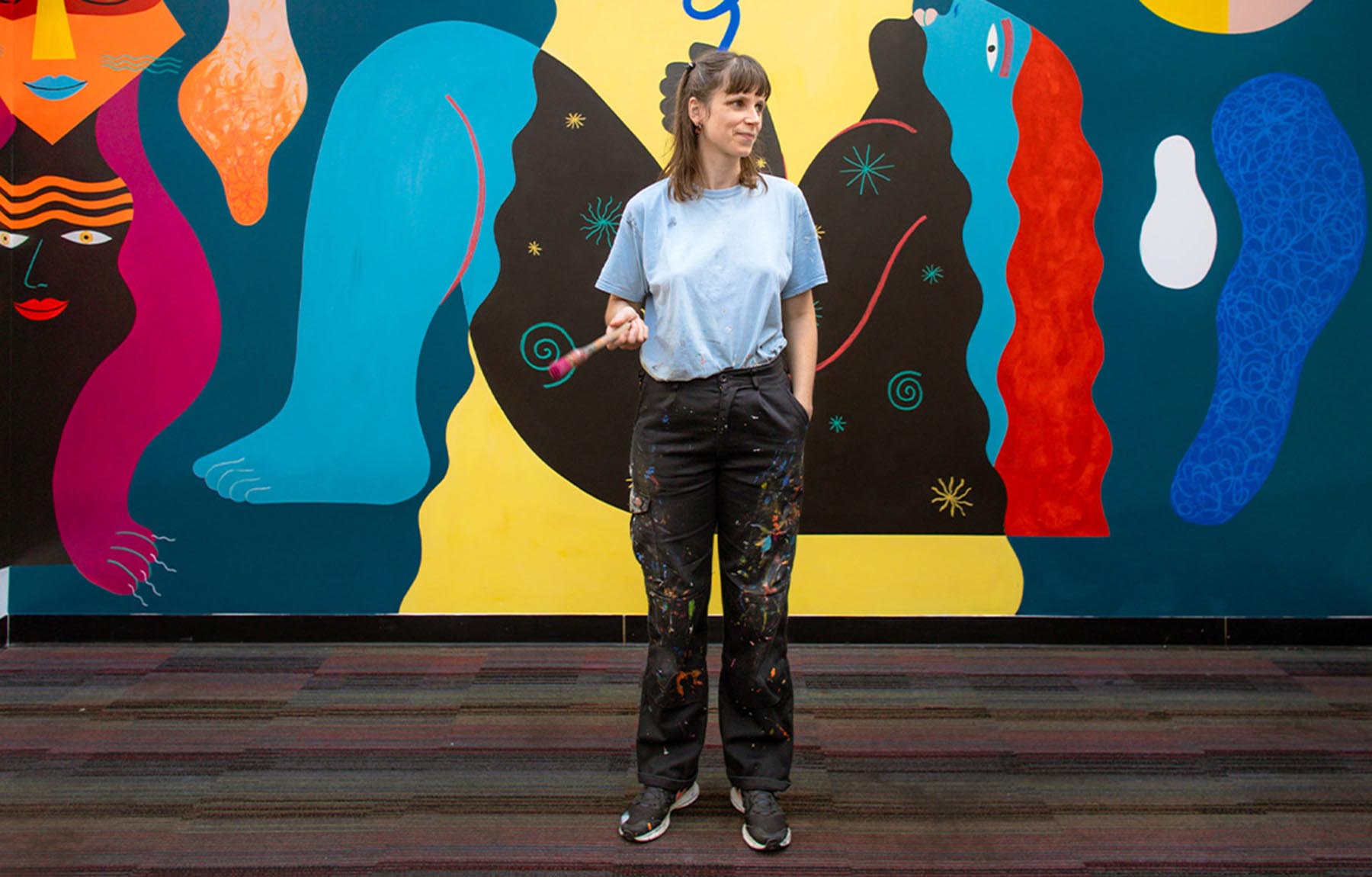
Over the last couple of weeks, we had Illustrator and UCA alum, Margaux Carpentier, on campus, working on an incredible mural in our Farnham canteen.

Discover UCA for yourself:
We are experimental and playfully commercial
Alumni include Paul Blow, Petronella Hall and TV legend Tony Hart
Currently Viewing:
Location
Farnham
Start date
Sept 2026
Duration
3 years full-time

UCAS codes
Course: W220
Institution: C93
Foundation year
Optional extra year of study
Placement year
Optional extra year of study
Entry requirements
Check country qualificationsTuition fees
Check fees and view funding optionsPlayfully creative. Experimental. Commercially relevant. These are all ways to describe our exciting BA (Hons) Illustration degree course at UCA Farnham.
This Illustration course has a strong sense of purpose – we want you to test what the language of illustration means to today’s audiences, make (and learn from) mistakes, research and generate ideas, and learn how to be entrepreneurial.
By placing experimentation and play at the forefront of what you'll do, you'll be challenged to take risks with your work, try new ways of working and be adventurous.
When you study illustration at UCA you'll get to work on exciting projects that are a combination of client-focused live briefs and external competitions with partners. This includes leading restaurant chains, hotels, magazines and local and multinational businesses. You'll also be given the opportunity to present your portfolio to illustration agencies, design houses, and art directors.
Everything on this course is practice-based, with theory, context, and research built in. Based in our creative studio, you’ll be part of an amazing community, where staff – who are all practising illustrators and artists – will push you to be the best you can possibly be.
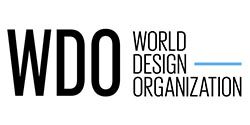
The World Design Organization (WDO) is a global network of almost 200 members. It is an international non-governmental organisation that promotes the profession of design and its ability to generate better products, systems, services, and experiences; better business and industry; and ultimately a better environment and society.
We’re privileged to be able to share our graduates’ incredible work with the world, click on the work below to see more images and find out about the project.
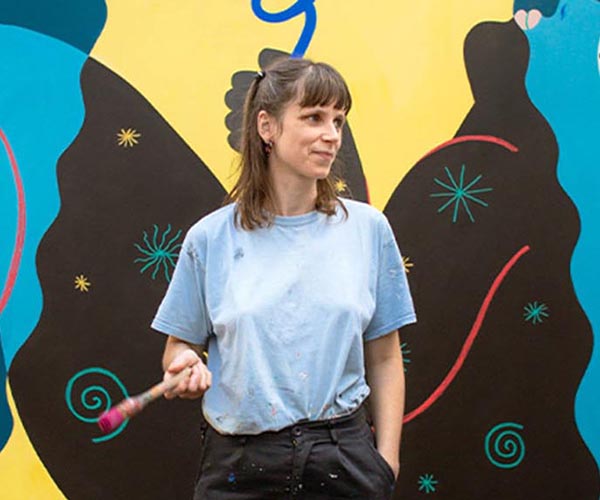

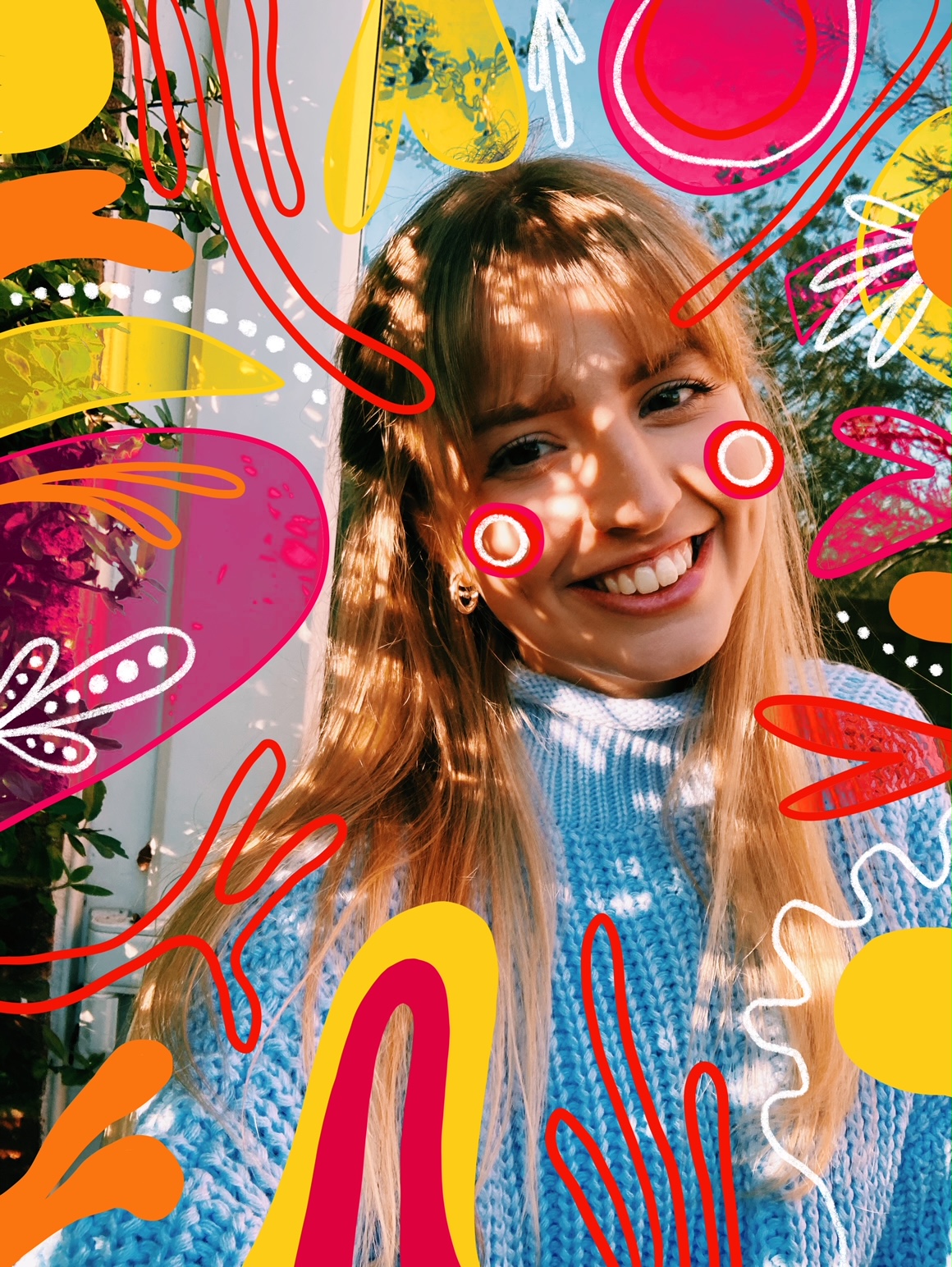
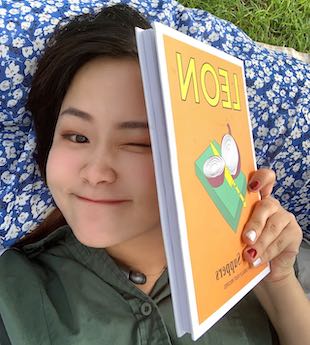
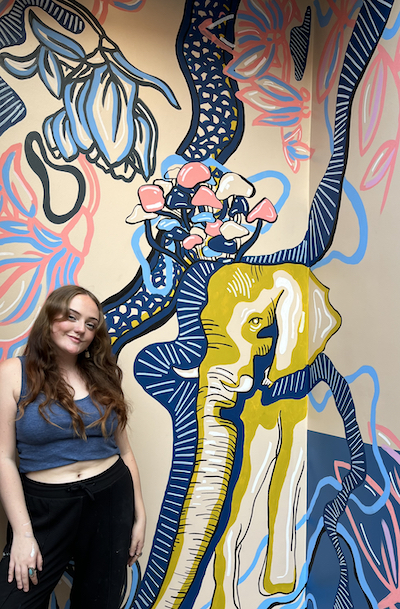

Over the last couple of weeks, we had Illustrator and UCA alum, Margaux Carpentier, on campus, working on an incredible mural in our Farnham canteen.

Discover UCA for yourself:
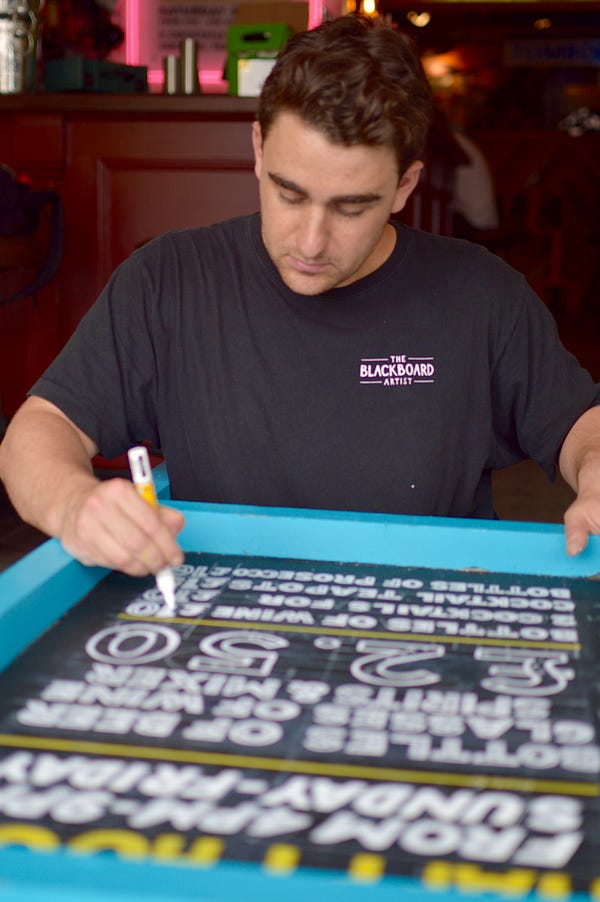

Now better known as The Blackboard Artist, Michael travels the country designing stunning blackboards and other signage for restaurants, bars, coffee shops and lots of other independent businesses.
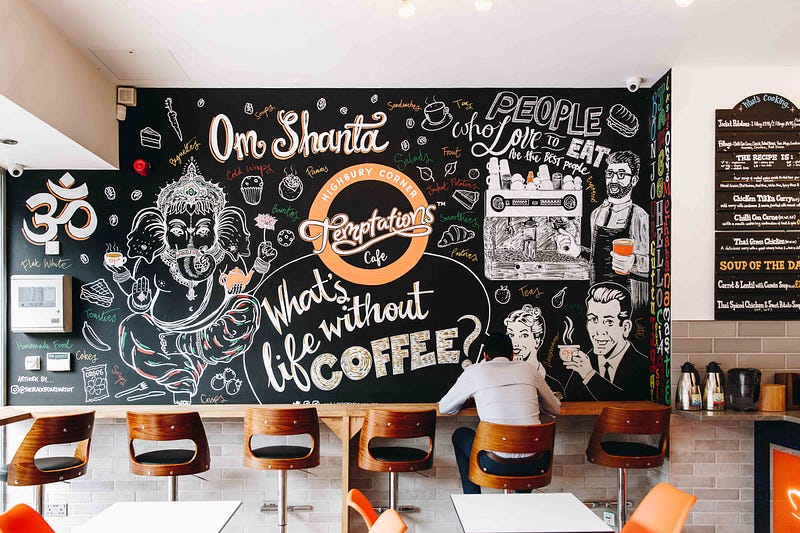
Michael has worked with established companies such as Soho House, Virgin, Strada, Everyman Cinema, Big Easy and Simmons Bars.

During COVID lockdowns Michael turned to teaching, running online Zoom lessons for blackboard enthusiasts.

Try your very best to turn every negative into a positive. Seven years ago when I started working on blackboards I was low in confidence and working in a pub kitchen as a kitchen porter, but I worked really hard to build my business on the side, as I knew painting was one of my passions.

Discover UCA for yourself:
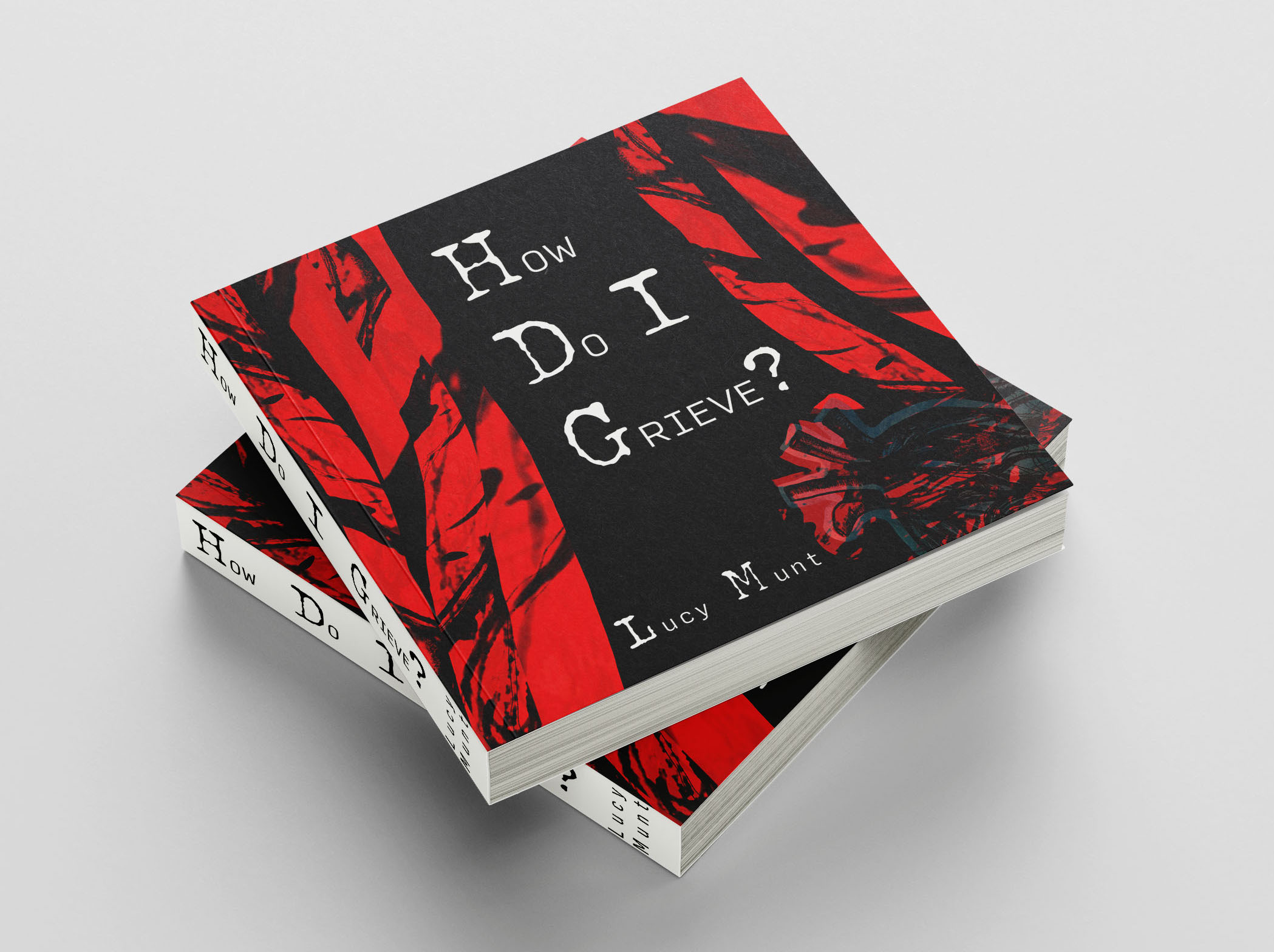
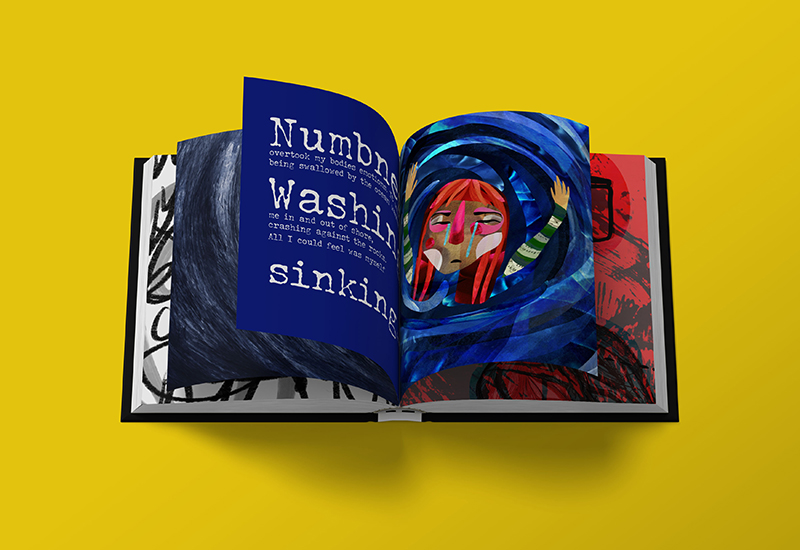
After losing someone close to her Lucy set out to use her talents to help other young adults coping with loss.
She used her own experience as motivation for the four-month project.

I lost someone very close to me and it was a sudden death, which was an experience that I wish no one had to go through. But I found there were no engaging or visual books to help me understand what I was going through, and young adults are experiencing more problematic responses to loss than we think.
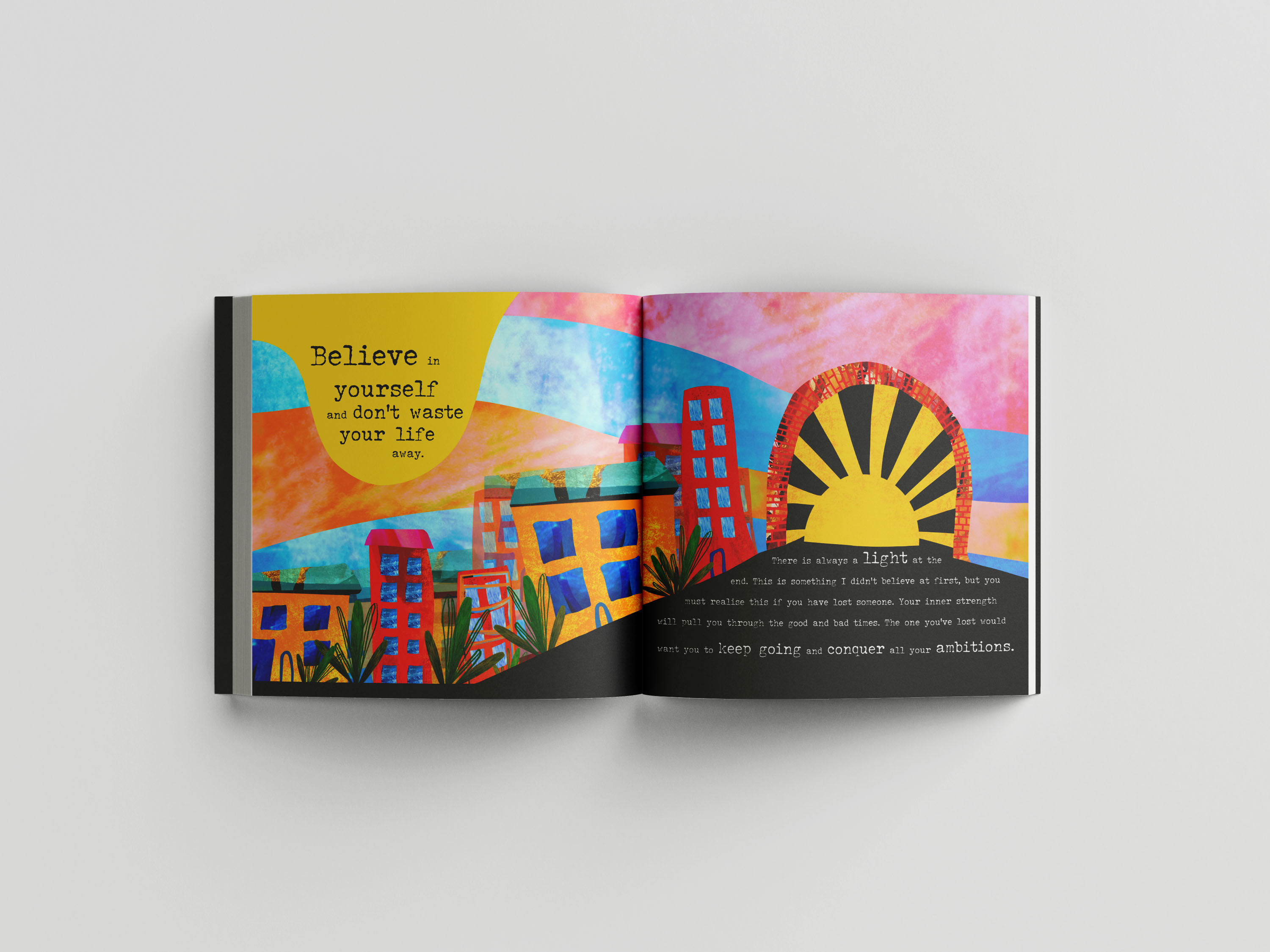
The result of Lucy’s hard work is her beautiful book, which uses metaphorical objects to help the reader see grieving through symbols, which she uses to communicate emotions and feelings.
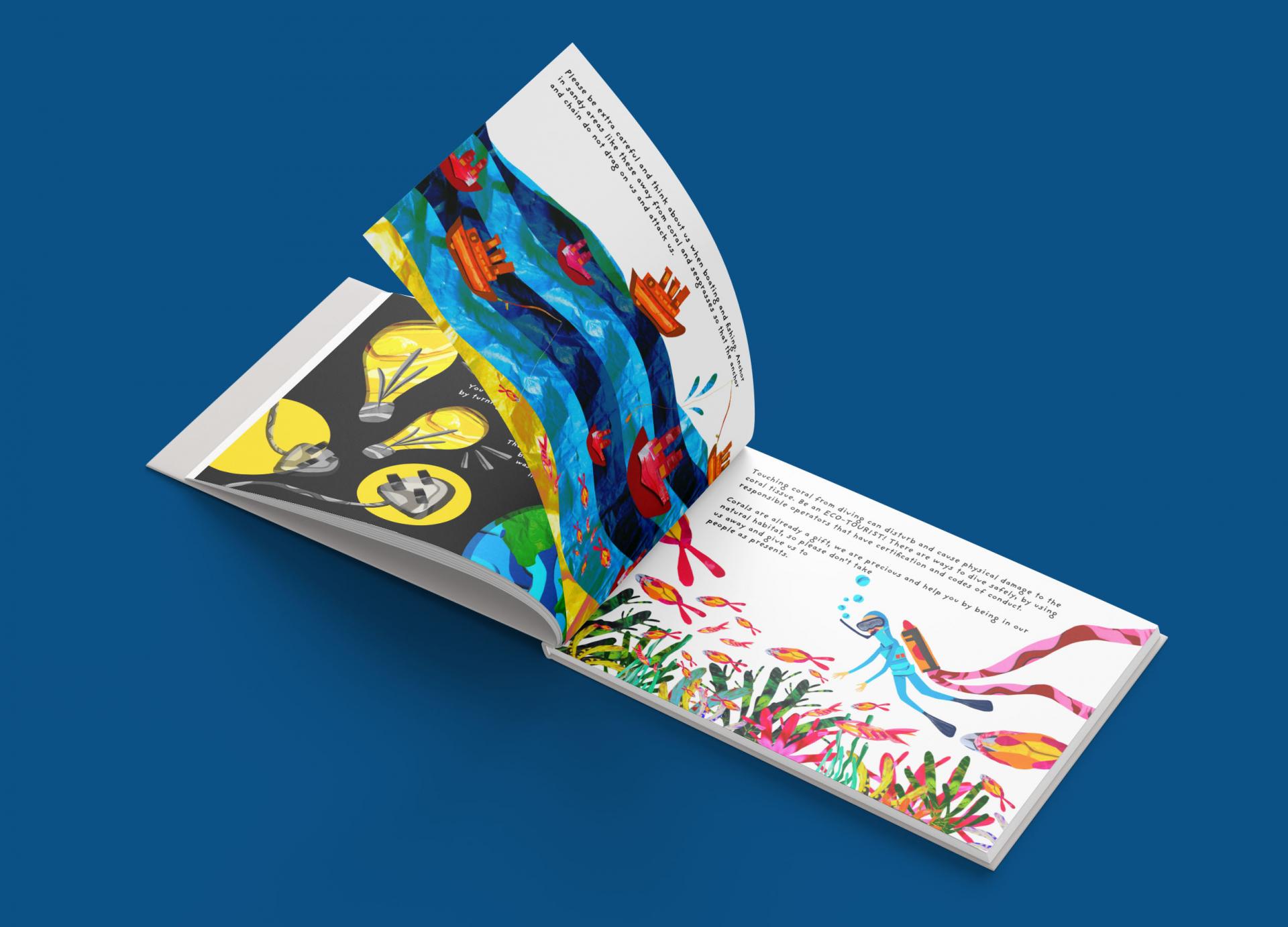
I like making images that can make a difference to people, whether that’s as part of educational books or just fun, creative illustrations that make people smile.

Discover UCA for yourself:
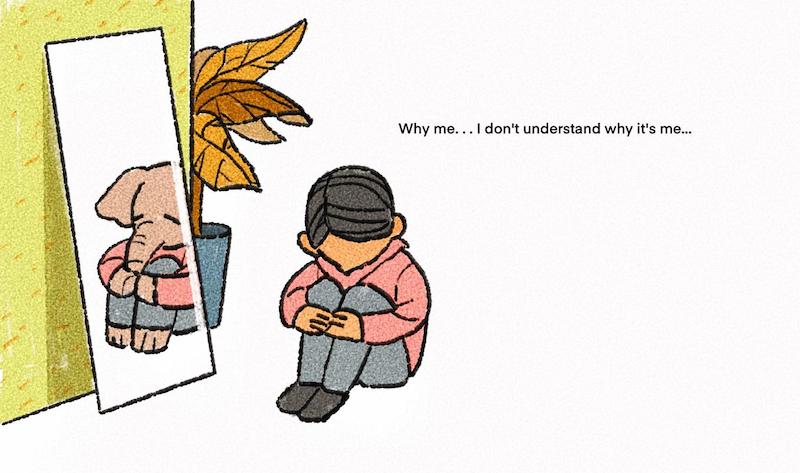
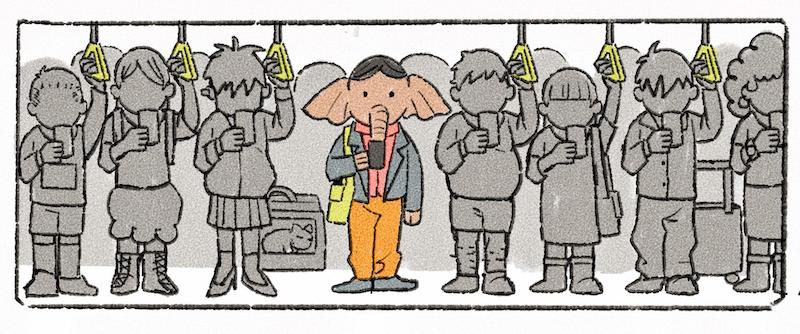
Xuan's book (The Elephant) details how the main character – a girl with Tourette’s, goes on a journey from finding she has the condition, to accepting herself.
When she has an attack, parts of her body turn into an elephant – making the phrase “the elephant in the room”, a metaphor for the disorder.
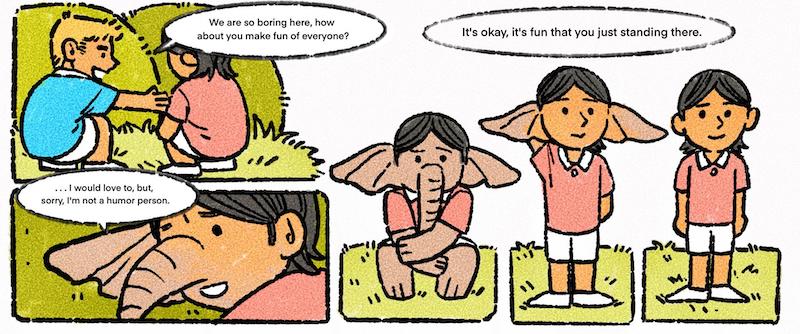
Xuan, who hopes to become a freelance illustrator, took three months creating her book and is important to her as she herself has the condition.

It affects me a lot, I sometimes have insomnia, and I sometimes have trouble concentrating and twitching... I liken Tourette's to an elephant in the comics because that's how I feel... everyone knows I'm different, even think I'm weird, but because they are adults, they don't say it directly.
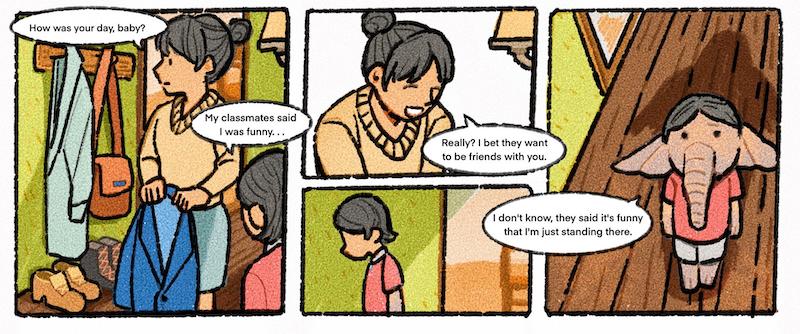
'I hope that people without Tourette Syndrome read this cartoon more than people with it, because I want everyone to know more about this disease.'

Discover UCA for yourself:
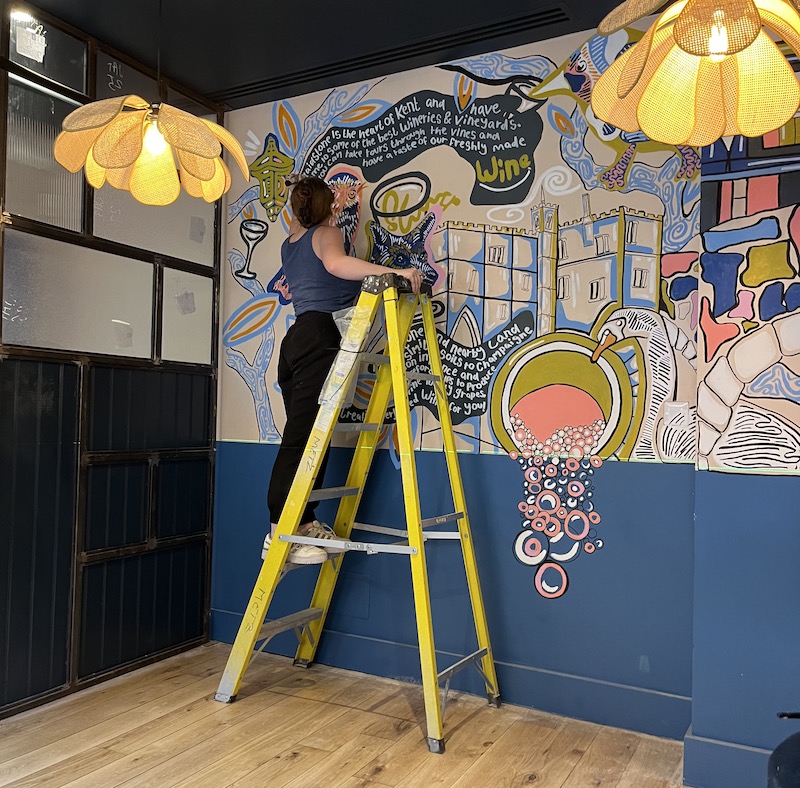

Bri, a third-year UCA Illustration student, has transformed two huge wall spaces at the Maidstone branch of Zizzi, using a colour palette inspired by the local area.
It’s the second time this year that UCA students have put their talents to the test, after Ruth Blacklock and Izzy Barrett transformed Zizzi in Farnham.
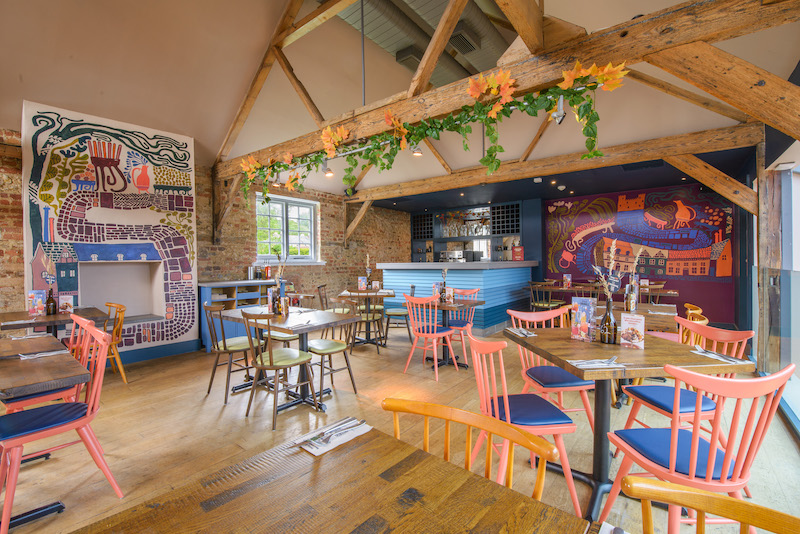 Izzy's work in Farnham
Izzy's work in Farnham
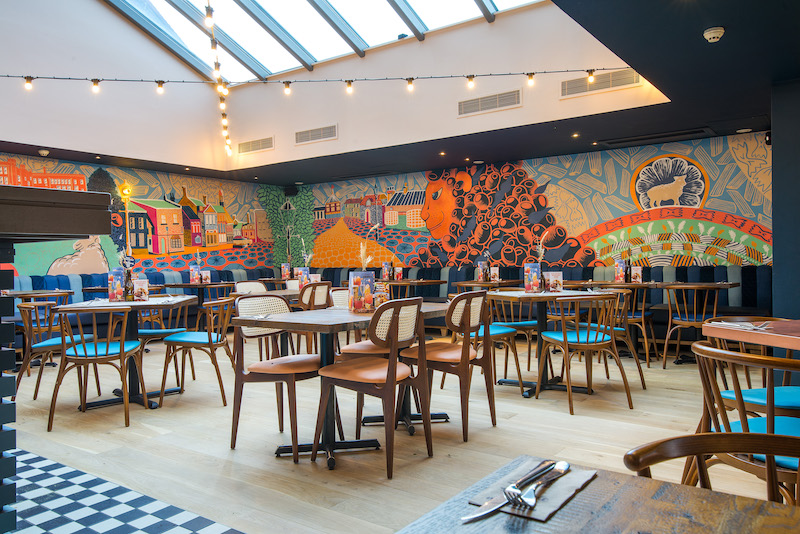 Ruth's work in Farnham
Ruth's work in Farnham
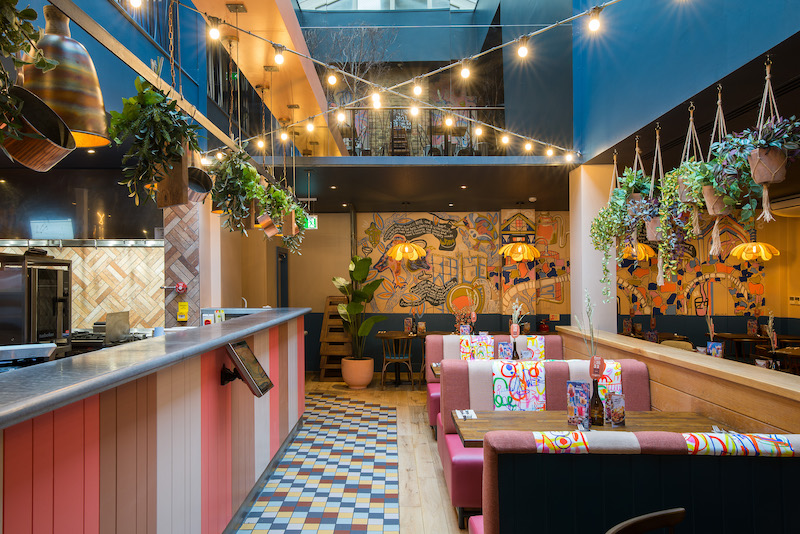
Bri was later commissioned to design and paint a mural on the UCA Farnham campus...

Discover UCA for yourself:
The content of the course may be subject to change. Curriculum content is provided as a guide.
UCA’s Integrated Foundation Year is designed to give you the skills you’ll need to start your degree in the best possible way – with confidence, solid knowledge of creative practice, study skills and more.
You’ll explore a range of creative techniques and develop your portfolio, with your chosen subject in mind. We’ll work with you throughout the year to ensure you’re on the right track and give you the tools to achieve your highest potential on your degree.
Find out more about the Integrated Foundation Year
Launch
You’ll be introduced to the course, the staff team, and to campus spaces and resources. A lively and varied programme of workshops, activities and exercises will bond them as a group and introduce them to the wider contexts of image-making and illustration. The focus will be on playful, high tempo activities that sow enthusiasm for the coming year.
Fundamentals 1
As you start out on your journey of exploration, you’ll be introduced to the building blocks of illustration. You’ll examine its fundamental objective - to convey information through visual imagery in order to inform, describe, express, embellish, interpret and represent ideas - and look at the broad strategic remit of the discipline: to bring image-based solutions to agreed communication agendas.
Equality, Diversity and Inclusivity 1
As visual practitioners we have a responsibility for the socio-political make-up of our lives and the lives of others, so you’ll need to think critically about how our worlds are created, and to work together within relationships, communities and collectives. You’ll begin to develop an understanding of perspectives and practices that are unfamiliar; a language to begin to articulate visual culture in relation to socio-political issues; an ability to situate your practices within a global context.
Impact 1
How are images delivered and who sees them? How can we create and deepen engagement using imagery and how can we measure its success? This unit asks you to consider the reach and impact of illustration in its current and speculative forms. You’ll learn about users and audiences to begin to develop an understanding of how illustration and other forms of imagery are transmitted and understood.
Opportunity
This opportunity week will recap on learning achieved in the year to date, reviewing student progress in term 1, and introduce the themes, topics and agendas for the term ahead. This will be achieved via a series of design sprints and live challenges – such as creating and publishing content for a group-curated magazine, setting up a work in progress show or curating a public event.
Fundamentals 2
This unit builds on the skills and approaches undertaken in Fundamentals 1 by exploring the full global reach of illustration, in both its current and potential future form. You’ll consolidate the practical building blocks of image-making and expand on these by looking at experimental practices, reviewing image-based practice, collaborating to produce shared large-scale image projects, and begin to attempt external-facing projects.
Real World 1
As part of preparing for practice in future, this unit introduces you to the position of illustration in contemporary media and wider creative practice. You’ll be introduced to notions of where you fit into the design world, and what external possibilities might look like.
Showtime
This unit asks you to consider the possibilities of external display, as they relate to your own image-making practice and ambitions. You will do this by selecting and participating fully in a series of School-wide events across the year, recording and reflecting on them regularly in a cumulative digital outcome, and final Unit Report and a publicly accessible showcase.
Launch
This week will be used to introduce you to the scope and possibility of your Year 2 experience, examining the existing and future horizons of the subject. Specialist options within chosen areas of illustration - such as narrative and storytelling, moving image, data visualisation, 3D/spatial, and reportage – will be finalised, and summer projects reprised to frame the progress of their journey across this crucial year and into your final year.
Studio 1
This module embeds and extends your core illustration studio skills, including drawing, printmaking, composition, photography, and key software, and you’ll consolidate the studio culture you’ve been introduced to. It also offers optionality by presenting a choice of specialist design briefs from a spectrum of image-making sub-disciplines.
The conscious practitioner
You’ll interrogate visual culture and communication practices beyond Eurocentric models, to challenge our assumptions and preconceptions. You’ll develop an ability to critically analyse and engage critically with perspectives and practices that are unfamiliar; to position your practice within those contexts and to use research and speculation to articulate your work in relation to socio-political issues and contexts.
Impact 2
You’ll consider new and responsive ways in which images can and might be used, both now and in future, to deepen engagement, reach users in new and interactive ways, and in so doing broaden the remit of the discipline. This unit builds on the first year Impact 1 unit and asks you to consider the reach and impact of illustration in its current and speculative forms.
Opportunity
This opportunity week will recap on learning achieved in the year to date, and introduce the themes, topics and agendas for both the remainder of the year and progression into Y3. This will be achieved via a series of live challenges and topic reviews, working with other student groups and years as appropriate
Studio 2
This unit builds on the studio skills explored in the Studio 1 unit to prepare your personal line of visual enquiry for final year study via self-written project work.
Real World 2
As part of preparing for practice in future, this unit builds on the positional stance you explored in your first year, as you began to look how illustration is situated within contemporary media and wider creative practice. You’ll be introduced to notions of where you fit into the design world, and what external possibilities might look like, as you prepare to source a work placement. You’ll build and test a portfolio / online showcase, and provide written rationales and visual mapping that explore the specialist areas pertinent to your visual interests.
Placement
You’ll consider and engage with the possibilities of external work and engagement, as they relate to your own image-making practice and ambitions and building on the Showtime unit undertaken in first year. This is all about developing your employability and enterprise skills and equips you with competencies needed for your future career within the world of illustration.
You also choose one elective unit from the list below:
Impact 2 (Elective)
You’ll consider new and responsive ways in which images can and might be used, both now and in future, to deepen engagement, reach users in new and interactive ways, and in so doing broaden the remit of the discipline. This unit builds on the first year Impact 1 unit.
Typographic Studies 2.0 (Elective)
This unit explores the critical thinking, creative and technical skills you need when working with large amounts of text. Increasingly graphic designers recognise their power and responsibilities in constructing and shaping messages, as well as in transmitting them. During this unit, you’ll develop an awareness of the many interpretive possibilities of even simple texts by experimenting with their typographic presentation and configuration, while learning the knowledge and techniques needed for editorial design and exploring.
If you opt to complete a professional practice year, this will take place in year three. You will undertake a placement within the creative industries to further develop your skills and CV.
While on your Professional Practice Year, you will be required to pay a reduced tuition fee for that year. This fee will be determined using government funding regulations. Based on current regulations, we expect this to be a maximum of 20% of the tuition fee rate that you are charged for your second year of study. You will also incur additional travel and accommodation costs during this year. The University will provide you with further advice and guidance about this as you approach your Professional Practice Year.
Please note: If you are an international applicant, you will need to enrol onto the course ‘with Professional Practice Year’. It will not be possible to transfer onto the Professional Practice Year after enrolment
Launch
This week will be used to introduce students to the scope and possibility of their final year experience, as they refine your own visual voice and build a professional profile as an effective and committed image-maker.
Visual Voice
The final year is a key time to build your own design voice, so that by the end, you can present a coherent body of design work of professional standard that engages and communicates effectively with a given audience. You’ll do a written design project, a collaborative brief, and a competition brief from a recognised national or international competition or awards scheme, such as the RSA, Penguin Design Awards, Folio Society, Macmillan Prize.
Critical Practice
You’ll interrogate a particular theme or topic, research it, gather material and analyse how it informs your ideas and practice.
Opportunity
You’ll recap on learning achieved in the year to date, and introduce the themes, topics and agendas for both the remainder of the year and progression into the workplace.
Final Project
This final provides the opportunity to examine a subject or theme in depth through a self-determined and challenging project, which will demonstrate the maturity of your visual communication skills. Work created in this unit will be exhibited in the end-of-year Degree Show and typically goes on to form a major component of student portfolios upon graduation.
This course is designed to offer you (if eligible) the opportunity to study part of your degree aboard at a UCA partner university, while still earning credits towards your UCA degree.
For more information please visit the Study Abroad section
Integrated foundation year
Year one
Year two
Year three
Professional practice or International year (if undertaken)
Please note, these details are for 2025 entry and could be subject to change for other years of entry.
Please note, syllabus content indicated is provided as a guide. The content of the course may be subject to change in line with our Student Terms and Conditions for example, as required by external professional bodies or to improve the quality of the course.
We offer a range of webinars throughout the year that you may be interested in:
If you opt to study the Professional Practice Year, for 2026 you will be required to pay a reduced tuition fee of £1,900. You will also incur additional travel and accommodation costs during your Professional Practice year. The University will provide you with further advice and guidance about this.
UK undergraduate tuition fees are linked to inflation and this means 2026 entry fees may increase. Details for these will be confirmed as soon as possible.
If you opt to study the Professional Practice Year, for 2026 you will be required to pay a reduced tuition fee of £1,900. You will also incur additional travel and accommodation costs during your Professional Practice year. The University will provide you with further advice and guidance about this.
UK undergraduate tuition fees are linked to inflation and this means 2026 entry fees may increase. Details for these will be confirmed as soon as possible.
If you opt to study the Professional Practice Year, for 2026 you will be required to pay a reduced tuition fee of £3,490. You will also incur additional travel and accommodation costs during your Professional Practice year. The University will provide you with further advice and guidance about this.
The fees listed here are correct for the stated academic year only, for details of previous years please see the full fee schedules.
At UCA we have a number of scholarships and fee discounts available to assist you with the cost of your studies.
There are lots of ways you can access additional financial support to help you fund your studies - both from UCA and from external sources. Discover what support you might qualify for please see our financial support information.
In addition to the tuition fees there may be other costs for your course. The things that you are likely to need to budget for to get the most out of a creative arts education will include books, printing costs, occasional or optional study trips and/or project materials.
These costs will vary according to the nature of your project work and the individual choices that you make. Please see the Additional Course Costs section of the Course Information Document for more details of the costs you may incur.
There are dedicated illustration studios with natural lighting for workshops, independent and group working. On campus, there are digital media suites programmed with design software for high-quality print production; printmaking studio with relief and block printing, plate or stone lithography, intaglio, letterpress, photopolymer plate printing and screen-printing; and a modern library with a wealth of books, journals, special collections and online resources.
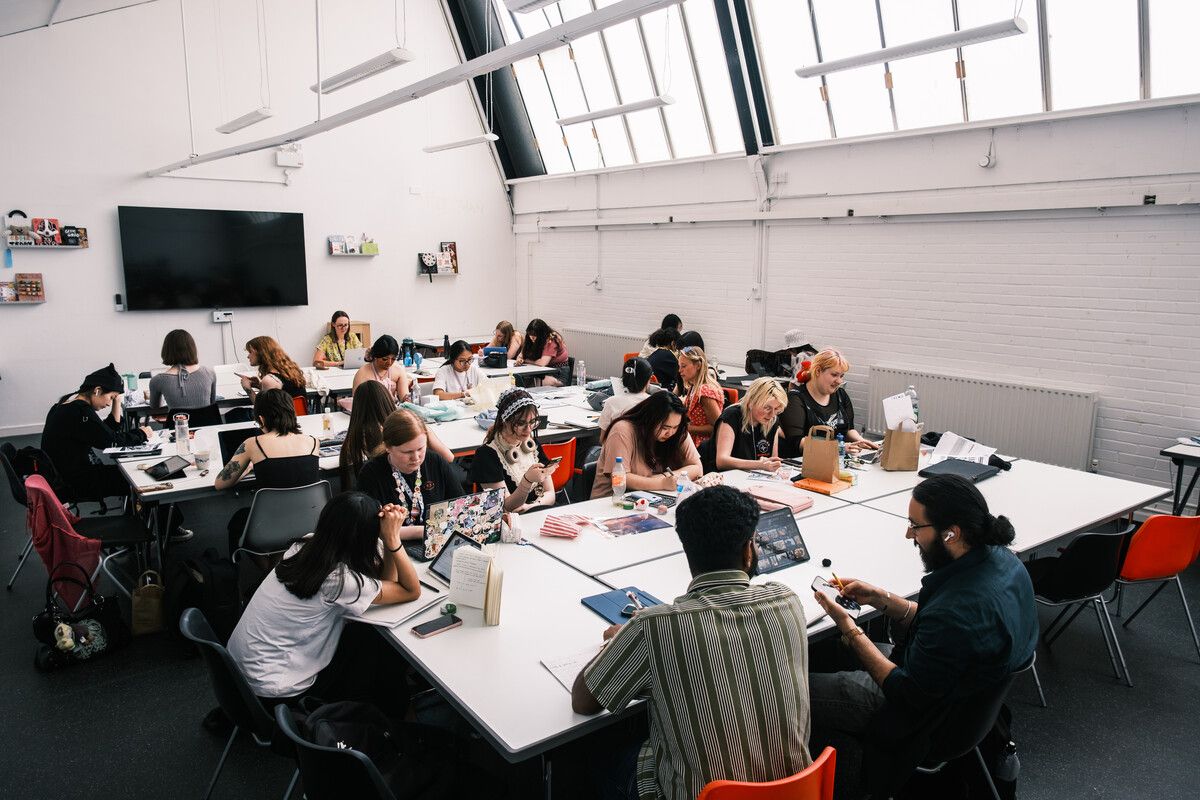
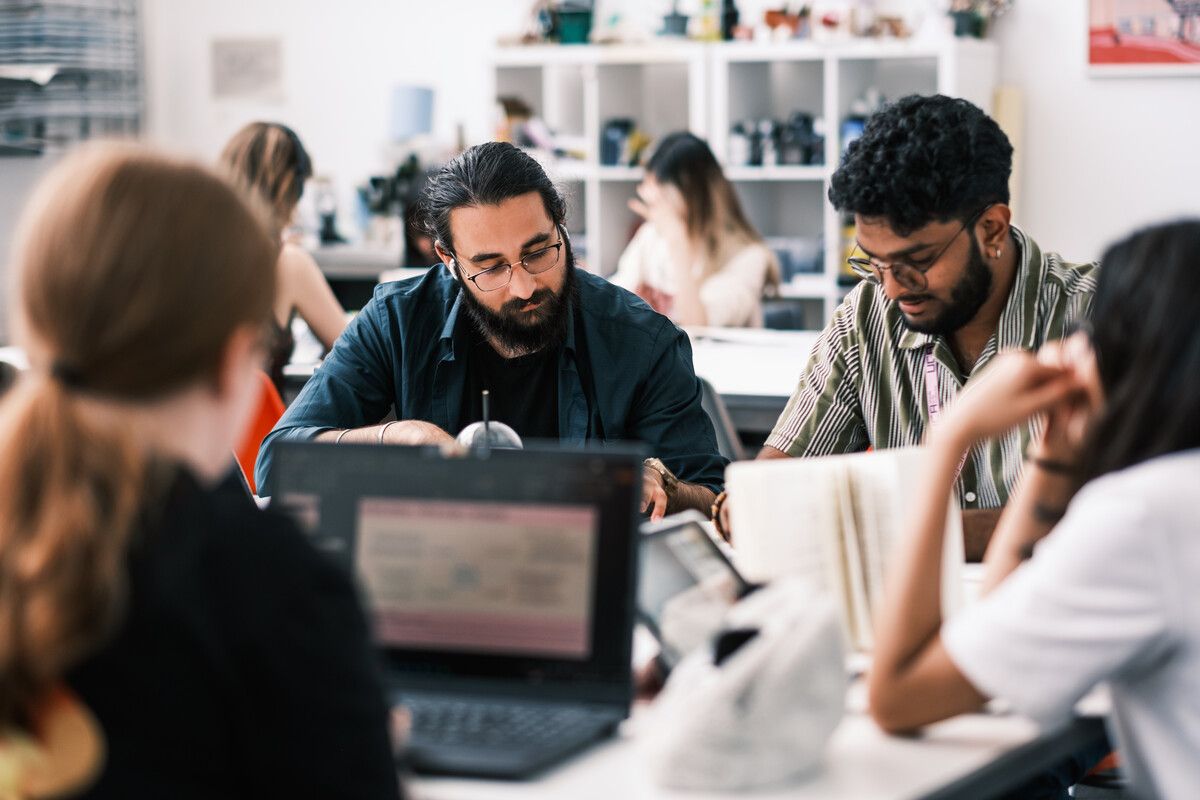
.jpg)

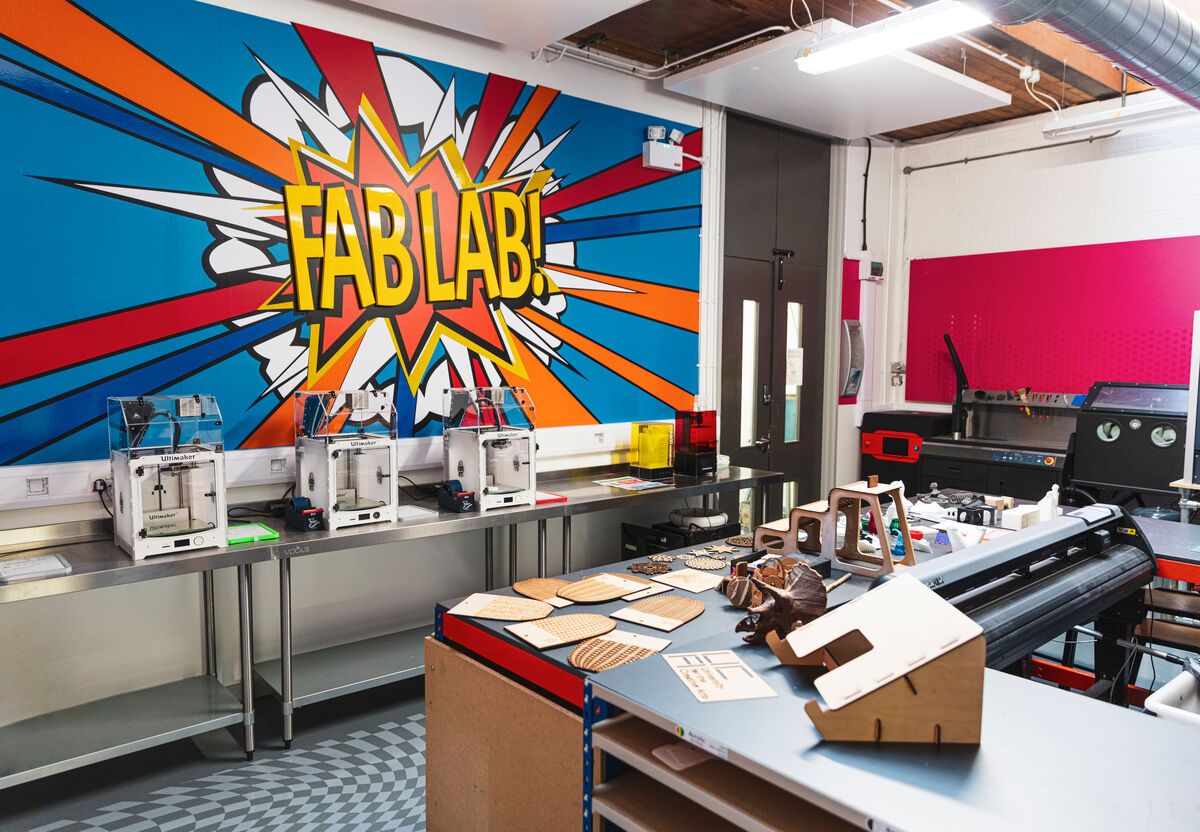

You’ll benefit from our well established industry links, including:
The course attracts a variety of guest speakers, such as Rosy Nicolas, Tim Ellis, Tom Dowse, Graham Rawle, Gina Cross, The Association of Illustrators, Stephen Appleby, Olivier Kugler, Matilda Tristram and David Lemm.
The degree is a member of the Association of Illustrators, which gives you access to notable industry practitioners, workshops, lectures and seminars by some of the top illustrators in the UK and Europe.
The diverse and versatile skill set you’ll develop on this course will open up a multitude of career paths.
Our recent graduates are currently working in:
You may also like to consider further study at postgraduate level.
We’ll need to see your portfolio for this course:
The standard entry requirements* for these courses are one of the following:
And four GCSE passes at grade 9-4/A*-C including English (or Functional Skills English/Key Skills Communication Level 2).
Other relevant and equivalent Level 3 UK and international qualifications are considered on an individual basis, and we encourage students from diverse educational backgrounds to apply.
The standard entry requirements* for foundation year entry are one of the following:
And four GCSE passes at grade 9-4/A*-C including English (or Functional Skills English/Key Skills Communication Level 2).
Other relevant and equivalent Level 3 UK and international qualifications are considered on an individual basis, and we encourage students from diverse educational backgrounds to apply.
*We occasionally make offers which are lower than the standard entry criteria, to students who have faced difficulties that have affected their performance and who were expected to achieve higher results. We consider the strength of our applicants’ portfolios, as well as their grades - in these cases, a strong portfolio is especially important.
For our Bachelor’s courses, we usually require that you have a Grade 14 Diploma with 60% overall.
For our International Foundation in Creative Practices and our Integrated Foundation courses, we usually require that you have a Grade 12 Graduation Certificate with 60% overall.
For our International Foundation in Creative Practices and our Integrated Foundation courses we can also consider five IGCSE's with grades 9-4/A*-C.
If you take the IELTS test you will need to achieve the following scores (or an equivalent from other UCA-approved English tests):
For our Bachelor's courses, we usually require that you have a transcript showing successful completion of year 1 of a Bachelor's degree, with an average grade of 7/10 or better, from a recognised Albanian university.
For our International Foundation in Creative Practices and our Integrated Foundation courses, we usually require that you have an Albanian Diplomë e Maturës Shtetërore (Diploma of State Matura) with 6/10 or better.
For our International Foundation in Creative Practices and our Integrated Foundation courses we can also consider five IGCSE's with grades 9-4/A*-C.
If you take the IELTS test you will need to achieve the following scores (or an equivalent from other UCA-approved English tests):
View more information for students from Algeria 🇩🇿
For our Bachelor's courses, we usually require that you have a Brevet de Technicien Superier with a score of 12/20.
For our International Foundation in Creative Practices and our Integrated Foundation courses, we usually require that you have a Baccalauréat de l'Enseignement Secondaire with a score of 12/20.
For our International Foundation in Creative Practices and our Integrated Foundation courses we can also consider five IGCSE's with grades 9-4/A*-C.
If you take the IELTS test you will need to achieve the following scores (or an equivalent from other UCA-approved English tests):
For our Bachelor's courses, we usually require that you have one of the following:
For our International Foundation in Creative Practices and our Integrated Foundation courses, we usually require that you have an Argentinian Título de Bachiller with an average grade 6 or better.
For our International Foundation in Creative Practices and our Integrated Foundation courses we can also consider five IGCSE's with grades 9-4/A*-C.
If you take the IELTS test you will need to achieve the following scores (or an equivalent from other UCA-approved English tests):
For our Bachelor's courses, we usually require that you have one of the following:
For our International Foundation in Creative Practices and our Integrated Foundation courses, we usually require that you have an Armenian Certificate of Secondary General Education with grade 7.5 or better.
For our International Foundation in Creative Practices and our Integrated Foundation courses we can also consider five IGCSE's with grades 9-4/A*-C.
If you take the IELTS test you will need to achieve the following scores (or an equivalent from other UCA-approved English tests):
View more information for students from Australia 🇦🇺
For our Bachelor's courses, we usually require that you have one of the following:
We also require Australia Year 10 Certificate with English C or above.
For our International Foundation in Creative Practices and our Integrated Foundation courses, we usually require that you have a satisfactory pass in your Australian Certificate of Education or equivalent school qualification.
For our International Foundation in Creative Practices and our Integrated Foundation courses we can also consider five IGCSE's with grades 9-4/A*-C.
View more information for students from Austria 🇦🇹
For our Bachelor's courses, we usually require that you have a Reife und Diplomprufung/Matura OR Reifeprufung/Matura with minimum grade 2.2.
For our International Foundation in Creative Practices and our Integrated Foundation courses, we usually require that you have a Reife und Diplomprufung/Matura OR Reifeprufung/Matura with minimum grade 4.
For our International Foundation in Creative Practices and our Integrated Foundation courses we can also consider five IGCSE's with grades 9-4/A*-C.
We accept Matura/Reifeprufung. You must attain a 2 (gut) in English Language in both written and oral exams.
If you take the IELTS test you will need to achieve the following scores (or an equivalent from other UCA-approved English tests):
For our Bachelor's courses, we can accept a Study Net Group International Foundation Year with 60% overall grade.
Please contact internationaladmissions@uca.ac.uk for more information on foundation year entry requirements.
For our International Foundation in Creative Practices and our Integrated Foundation courses we can also consider five IGCSE's with grades 9-4/A*-C.
If you take the IELTS test you will need to achieve the following scores (or an equivalent from other UCA-approved English tests):
For our Bachelor's courses, we usually require that you have a Bahamas Associate of Applied Science or Associate of Arts / Science.
For our International Foundation in Creative Practices and our Integrated Foundation courses, we usually require that you have Bahamas GCSEs in at least five subjects with grade C or better.
For our International Foundation in Creative Practices and our Integrated Foundation courses we can also consider five IGCSE's with grades 9-4/A*-C.
If you take the IELTS test you will need to achieve the following scores (or an equivalent from other UCA-approved English tests):
View more information for students from Bahrain 🇧🇭
For our Bachelor's courses, we usually require that you have one of the following:
For our International Foundation in Creative Practices and our Integrated Foundation courses, we usually require that you have a Bahraini Tawjahiya / Shahadat Al-Thanawaya Al-Aama (General Secondary Education Certificate) with an average grade of 70%.
For our International Foundation in Creative Practices and our Integrated Foundation courses we can also consider five IGCSE's with grades 9-4/A*-C.
If you take the IELTS test you will need to achieve the following scores (or an equivalent from other UCA-approved English tests):
View more information for students from Bangladesh 🇧🇩
For our Bachelor's courses, we usually require that you have either:
For our Integrated Foundation courses, we usually require that you have a Bangladeshi Higher Secondary Certificate, showing 12 years of completed school study, with 3.0 out of 5.0 or better. We can also consider five IGCSE's with grades 9-4/A*-C.
For our International Foundation in Creative Practices course, UCA will not be able to accept applications from the Bangladesh region.
If you take the IELTS test you will need to achieve the following scores (or an equivalent from other UCA-approved English tests):
For our Bachelor's courses, we usually require that you have one of the following:
For our International Foundation in Creative Practices and our Integrated Foundation courses, we usually require that you have a Caribbean Examinations Council Secondary Education Certificate (CSEC) with grade 3 in 5 subjects.
For our International Foundation in Creative Practices and our Integrated Foundation courses we can also consider five IGCSE's with grades 9-4/A*-C.
For Bachelor's courses we can accept the Caribbean Examinations Council Secondary Education Certificate, English grade 3 (General Proficiency). If you are a national of Barbados, we will be able to accept your degree level qualification to meet our English Language requirement for Master's and PhD courses.
If you take the IELTS test you will need to achieve the following scores (or an equivalent from other UCA-approved English tests):
For our Bachelor's courses, we usually require that you have one of the following:
For our International Foundation in Creative Practices and our Integrated Foundation courses, we usually require that you have a Certificate of General Secondary Education with a score of 7/10 overall
For our International Foundation in Creative Practices and our Integrated Foundation courses we can also consider five IGCSE's with grades 9-4/A*-C.
If you take the IELTS test you will need to achieve the following scores (or an equivalent from other UCA-approved English tests):
View more information for students from Belgium 🇧🇪
For our Bachelor's courses, we usually require that you have a 70% in one of the following:
For our International Foundation in Creative Practices and our Integrated Foundation courses, we usually require 60% in one of the following:
For our International Foundation in Creative Practices and our Integrated Foundation courses we can also consider five IGCSE's with grades 9-4/A*-C.
We can accept a mark of 8/80% / grote onderscheiding / grande distinction in English as part of the Getuigschrift Van Hoger Secundair Onderwijs or Certificat d'Enseignement Secondaire Superieur qualification.
If you take the IELTS test you will need to achieve the following scores (or an equivalent from other UCA-approved English tests):
For our Bachelor's courses, we usually require that you have a Diplome d'Etudes Techniques Superieures grade 12.
For our International Foundation in Creative Practices and our Integrated Foundation courses, we usually require that you have a Baccalauréat or equivalent with 12/20.
For our International Foundation in Creative Practices and our Integrated Foundation courses we can also consider five IGCSE's with grades 9-4/A*-C.
If you take the IELTS test you will need to achieve the following scores (or an equivalent from other UCA-approved English tests):
For our Bachelor's level courses, we usually require that you have a Bermudan Associate degree.
For our International Foundation in Creative Practices and our Integrated Foundation courses, we usually require that you have a Bermuda School Diploma 70%.
For our International Foundation in Creative Practices and our Integrated Foundation courses we can also consider five IGCSE's with grades 9-4/A*-C.
If you take the IELTS test you will need to achieve the following scores (or an equivalent from other UCA-approved English tests):
View more information for students from Bhutan 🇧🇹
For our Bachelor's courses, we usually require that you have a Bhutan Higher Secondary Education Certificate 60%.
For our International Foundation in Creative Practices and our Integrated Foundation courses, we usually require that you have a Bhutan Higher Secondary Education Certificate (BHSEC) with a minimum of 50%.
For our International Foundation in Creative Practices and our Integrated Foundation courses we can also consider five IGCSE's with grades 9-4/A*-C.
We can accept 65% or higher in the HSEC (12th standard) English subject.
If you take the IELTS test you will need to achieve the following scores (or an equivalent from other UCA-approved English tests):
For our Bachelor's courses, we usually require that you have on of the following:
For our International Foundation in Creative Practices and our Integrated Foundation courses, we usually require that you have a Diploma de Bachiller Cientifico - Humanistico or Diploma de Bachiller Tecnico (12 years of schooling) with a score of at least 60.
For our International Foundation in Creative Practices and our Integrated Foundation courses we can also consider five IGCSE's with grades 9-4/A*-C.
If you take the IELTS test you will need to achieve the following scores (or an equivalent from other UCA-approved English tests):
For our Bachelor's courses, we usually require that you have one of the following:
For our International Foundation in Creative Practices and our Integrated Foundation courses, we usually require that you have one of the following:
For our International Foundation in Creative Practices and our Integrated Foundation courses we can also consider five IGCSE's with grades 9-4/A*-C.
If you take the IELTS test you will need to achieve the following scores (or an equivalent from other UCA-approved English tests):
For our Bachelor's courses, we usually require that you have a transcript showing successful completion of one year of university study at a recognised Brazilian university, with an average of 5.0.
For our International Foundation in Creative Practices and our Integrated Foundation courses, we usually require that you have a Certificado de Conclusão de Ensino Médio or Título de Técnico with at least 5, and evidence that you have passed your Vestibular, ENEM or PAS.
For our International Foundation in Creative Practices and our Integrated Foundation courses we can also consider five IGCSE's with grades 9-4/A*-C.
If you take the IELTS test you will need to achieve the following scores (or an equivalent from other UCA-approved English tests):
View more information for students from Brunei 🇧🇳
For our Bachelor's courses, we usually require that you have one of the following:
For our International Foundation in Creative Practices and our Integrated Foundation courses, we usually require that you have a Brunei / Cambridge GCE A levels with at least one grade C or equivalent.
For our International Foundation in Creative Practices and our Integrated Foundation courses we can also consider five IGCSE's with grades 9-4/A*-C.
If you take the IELTS test you will need to achieve the following scores (or an equivalent from other UCA-approved English tests):
View more information for students from Bulgaria 🇧🇬
For our Bachelor's courses, we usually require that you have a Bulgarian Diploma za sredno obrazovanie obtaining minimum overall grade 5.0, or 5.2 or above for Architecture.
For our International Foundation in Creative Practices and our Integrated Foundation courses, we usually require that you have a Bulgarian Diploma za sredno obrazovanie obtaining minimum overall grade 3 or above.
For our International Foundation in Creative Practices and our Integrated Foundation courses we can also consider five IGCSE's with grades 9-4/A*-C.
Diploma za sredno obrazovani with grade 5 in English Language is accepted at UCA.
If you take the IELTS test you will need to achieve the following scores (or an equivalent from other UCA-approved English tests):
View more information for students from Cambodia 🇰🇭
For our Bachelor's courses, we usually require that you have a Cambodian Associate Degree with satisfactory grades.
For our International Foundation in Creative Practices and our Integrated Foundation courses, we usually require that you have a Cambodian Diploma of Upper Secondary Education with at least Grade C.
For our International Foundation in Creative Practices and our Integrated Foundation courses we can also consider five IGCSE's with grades 9-4/A*-C.
If you take the IELTS test you will need to achieve the following scores (or an equivalent from other UCA-approved English tests):
For our Bachelor's courses, we usually require that you have successfully completed the Brevet de Technicien Supérieur with 11/20 or standard A-levels are required.
For our International Foundation in Creative Practices and our Integrated Foundation courses, we usually require that you have successfully completed a Baccalaureat of General Secondary Education at grade 12 or 5 O-levels at Grade C.
For our International Foundation in Creative Practices and our Integrated Foundation courses we can also consider five IGCSE's with grades 9-4/A*-C.
Bacculareate English Language currently accepted with minimum score of 12. We can also accept English Language-Literature studied as part of the British or American Option of the Baccalauréat avec Option Internationale, where a grade of 10 or above has been obtained.
If you take the IELTS test you will need to achieve the following scores (or an equivalent from other UCA-approved English tests):
View more information for students from Canada 🇨🇦
For our Bachelor's courses, we usually require that you have one of the following:
For our International Foundation in Creative Practices and our Integrated International courses, we usually require that you have a satisfactory passes in your Canadian Secondary School Diploma or equivalent school qualification.
For our International Foundation in Creative Practices and our Integrated Foundation courses we can also consider five IGCSE's with grades 9-4/A*-C.
For undergraduate applicants who have completed Grade 12 Canadian High School/Secondary School qualifications, we require grade B or 75% in a grade 12 English module.
For postgraduate applicants, if you are a Canadian national we will be able to accept your degree level qualification to meet our English Language requirement.
If you take the IELTS test you will need to achieve the following scores (or an equivalent from other UCA-approved English tests):
For our Bachelor's courses, we usually require that you have one of the following:
For our International Foundation in Creative Practices and our Integrated Foundation courses, we usually require that you have a Chilean Licencia de Educación / Enseñanza Media / Técnico de Nivel Medio with average grade 5 and with minimum grade 4 in all subjects.
For our International Foundation in Creative Practices and our Integrated Foundation courses we can also consider five IGCSE's with grades 9-4/A*-C.
If you take the IELTS test you will need to achieve the following scores (or an equivalent from other UCA-approved English tests):
View more information for students from China 🇨🇳
For our Bachelor's courses, we usually require that you have either:
For our International Foundation in Creative Practices and our Integrated Foundation courses, we usually require that you have a Chinese Senior School graduation with 11 or 12 years of completed school study, with an average of 70% or above.
For our International Foundation in Creative Practices and our Integrated Foundation courses we can also consider five IGCSE's with grades 9-4/A*-C.
For January 2026 entry, the English language requirements for Masters degrees are 6.5 overall with no less than 5.5 in any section. Requirements for all other study levels match the September 2026 English language listed below.
If you take the IELTS test you will need to achieve the following scores (or an equivalent from other UCA-approved English tests):
For our Bachelor's courses, we usually require that you have a transcript showing successful completion of one year of university level study with average GPA of 3.5 from a recognised Colombian university.
For our International Foundation in Creative Practices and our Integrated Foundation courses, we usually require that you have a Colombian Bachillerato with 'desepeno basico'.
For our International Foundation in Creative Practices and our Integrated Foundation courses we can also consider five IGCSE's with grades 9-4/A*-C.
If you take the IELTS test you will need to achieve the following scores (or an equivalent from other UCA-approved English tests):
For our Bachelor's courses, we usually require that you have a French Baccalaureate or French Option Internationale du Baccalaureat (OIB) with 12 points overall or above.
For our International Foundation in Creative Practices and our Integrated Foundation courses, we usually require that you have a French Baccalaureate or French Option Internationale du Baccalaureat (OIB) with 10 points overall or above.
For our International Foundation in Creative Practices and our Integrated Foundation courses we can also consider five IGCSE's with grades 9-4/A*-C.
The French Bacculareate English Language is currently accepted with minimum score of 12. We can also accept English Language-Literature studied as part of the British or American Option of the Baccalauréat avec Option Internationale, where a grade of 10 or above has been obtained.
If you take the IELTS test you will need to achieve the following scores (or an equivalent from other UCA-approved English tests):
View more information for students from Croatia 🇭🇷
For our Bachelor's courses, we usually require that you have a Croatian Svjedodzba o Maturi (Matura Certificate) with a minimum mark of 3.8.
For our International Foundation in Creative Practices and our Integrated Foundation courses, we usually require that you have a Croatian Svjedodzba o Maturi (Matura Certificate) with a minimum mark of 2.
For our International Foundation in Creative Practices and our Integrated Foundation courses we can also consider five IGCSE's with grades 9-4/A*-C.
An English Language Grade 4 in Matura is accepted.
If you take the IELTS test you will need to achieve the following scores (or an equivalent from other UCA-approved English tests):
View more information for students from Cyprus 🇨🇾
For our Bachelor's courses, we usually require that you have one of the following:
For our International Foundation in Creative Practices and our Integrated Foundation courses, we usually require that you have:
For our International Foundation in Creative Practices and our Integrated Foundation courses we can also consider five IGCSE's with grades 9-4/A*-C.
Our Pre-Masters courses require a recognised bachelor degree or 3 year diploma with a strong portfolio in a relevant subject. Applicants will also need to meet any course-specific requirements.
We accept Cyprus/Cypriot Apolytirion with 18/20 in English (Upper Secondary School Leaving Certificate).
If you take the IELTS test you will need to achieve the following scores (or an equivalent from other UCA-approved English tests):
View more information for students from Czechia 🇨🇿
For our Bachelor's courses, we usually require that you have either a Czech Maturitni Zkouska/Maturita or Vysvedceni o maturitni zkousce (Secondary School Leaving Certificate) with a minimum of 2.5 overall.
For our International Foundation in Creative Practices and our Integrated Foundation courses, we usually require that you have a Czech Maturitni Zkouska/Maturita or Vysvedceni o maturitni zkousce (Secondary School Leaving Certificate) with a minimum of 4 overall.
For our International Foundation in Creative Practices and our Integrated Foundation courses we can also consider five IGCSE's with grades 9-4/A*-C.
For undergraduate degrees we require a Grade 2 or above in Maturitni Zkouska / Vysvedceni o Matuitni Zkousce.
For our Master's courses we require a Grade 1 Maturitni Zkouska / Vysvedceni o Matuitni Zkousce.
If you take the IELTS test you will need to achieve the following scores (or an equivalent from other UCA-approved English tests):
View more information for students from Denmark 🇩🇰
For our Bachelor's courses, we usually require that you have a Danish Studentereksamenor Hojere Forberedelseseksamenor Hojere Handelseksamen (HHX) / Hojere Teknisk Eksamen with minimum overall score 7 (if studying on 7 point scale) or 9 (if studying on 13 point scale).
For our International Foundation in Creative Practices and our Integrated Foundation courses, we usually require that you have a Danish Studentereksamenor Hojere Forberedelseseksamenor Hojere Handelseksamen (HHX) / Hojere Teknisk Eksamen with minimum overall score 2 (if studying on 7 point scale) or 6 (if studying on 13 point scale).
For our International Foundation in Creative Practices and our Integrated Foundation courses we can also consider five IGCSE's with grades 9-4/A*-C.
We accept a mark of 7 in English (levels A or B) as part of the Studentereksamen/ Hojere Forbesedels-Eksamen qualification.
If you take the IELTS test you will need to achieve the following scores (or an equivalent from other UCA-approved English tests):
For our Bachelor's courses, we usually require that you have a Técnico or Técnico Superior with C/70%.
For our International Foundation in Creative Practices and our Integrated Foundation courses, we usually require that you have a Bachillerato, taken after 12 years of schooling, with an average of 80% or better.
For our International Foundation in Creative Practices and our Integrated Foundation courses we can also consider five IGCSE's with grades 9-4/A*-C.
If you take the IELTS test you will need to achieve the following scores (or an equivalent from other UCA-approved English tests):
For our Bachelor's courses, we usually require that you have successfully completed the first year of an undergraduate degree (Licenciatura) with 7/10 or 70%.
For our International Foundation in Creative Practices and our Integrated Foundation courses, we usually require that you have an Ecuadorian Senior Secondary School (Bachillerato), with an overall grade of 14/20 or 7.5/10.
For our International Foundation in Creative Practices and our Integrated Foundation courses we can also consider five IGCSE's with grades 9-4/A*-C.
If you take the IELTS test you will need to achieve the following scores (or an equivalent from other UCA-approved English tests):
View more information for students from Egypt 🇪🇬
For our Bachelor's courses, we usually require that you have one of the following:
For our International Foundation in Creative Practices and our Integrated Foundation courses, we usually require that you have a General Secondary Education Certificate with 65% or above.
For our International Foundation in Creative Practices and our Integrated Foundation courses we can also consider five IGCSE's with grades 9-4/A*-C.
If you take the IELTS test you will need to achieve the following scores (or an equivalent from other UCA-approved English tests):
For our Bachelor's courses, we usually require that you have a Técnico with a score of 8 or better.
For our International Foundation in Creative Practices and our Integrated Foundation courses, we usually require that you have a completed Título de Bachiller or Título de Bachiller Técnico Vocacional with a score of 6 or better, following 12 years of completed schooling.
For our International Foundation in Creative Practices and our Integrated Foundation courses we can also consider five IGCSE's with grades 9-4/A*-C.
If you take the IELTS test you will need to achieve the following scores (or an equivalent from other UCA-approved English tests):
View more information for students from Estonia 🇪🇪
For our Bachelor's courses, we usually require that you have an Estonian Gumnaasiumi loputunnistus (Secondary School Certificate) with a minimum overall score 4.
For our International Foundation in Creative Practices and our Integrated Foundation courses, we usually require that you have an Estonian Gumnaasiumi loputunnistus (Secondary School Certificate) with a minimum overall score of 3.
For our International Foundation in Creative Practices and our Integrated Foundation courses we can also consider five IGCSE's with grades 9-4/A*-C.
English language B2 in Gumnaasumi loputunnistus is accepted.
If you take the IELTS test you will need to achieve the following scores (or an equivalent from other UCA-approved English tests):
View more information for students from Finland 🇫🇮
For our Bachelor's courses, we usually require that you have a Finnish Ylioppilastutkinto Studentexamen with Grade C / 4 (Cum laude approbatur) or above.
For our International Foundation in Creative Practices and our Integrated Foundation courses, we usually require that you have a Finnish Ylioppilastutkinto Studentexamen with Grade A / 2 (Approbatur) or above.
For our International Foundation in Creative Practices and our Integrated Foundation courses we can also consider five IGCSE's with grades 9-4/A*-C.
We require that you attain a mark of 5 (magna cum laude approbatur) in English as part of the Ylioppilastutkinto / Studentexamen qualification.
If you take the IELTS test you will need to achieve the following scores (or an equivalent from other UCA-approved English tests):
View more information for students from France 🇫🇷
For our Bachelor's courses, we usually require that you have a French Baccalaureate or French Option Internationale du Baccalaureat (OIB) with 12 points overall or above.
For our International Foundation in Creative Practices and our Integrated Foundation courses, we usually require that you have a French Baccalaureate or French Option Internationale du Baccalaureat (OIB) with 10 points overall or above.
For our International Foundation in Creative Practices and our Integrated Foundation courses we can also consider five IGCSE's with grades 9-4/A*-C.
A minimum score of 12 in the English component of your French Baccalaureate is required. We can also accept English Language-Literature studied as part of the British or American Option of the Baccalaureat avec Option Internationale.
If you take the IELTS test you will need to achieve the following scores (or an equivalent from other UCA-approved English tests):
For our Bachelor's courses, we usually require that you have:
For advanced entry (such as undergraduate top-up degrees) we usually require that you have a Gambia HND (2 years Orinary National Diploma + 2 years higher diploma).
For our International Foundation in Creative Practices and our Integrated Foundation courses, we usually require that you have an SSCE (WAEC) Senior Secondary School Certificate Examination) with five passes at grade C6 or above or IGCSE or equivalent.
For our International Foundation in Creative Practices and our Integrated Foundation courses we can also consider five IGCSE's with grades 9-4/A*-C.
A Senior School Certificate Examination - West African Exams Council (WAEC) delivered / assessed in English) with English at grade C6 or above is accepted.
If you take the IELTS test you will need to achieve the following scores (or an equivalent from other UCA-approved English tests):
For our Bachelor's courses, we usually require that you have successfully completed year 1 of Bachelor/Specialist Diploma: 60% or GPA 3.5/5.
For our International Foundation in Creative Practices and our Integrated Foundation courses, we usually require that you have a General education Diploma (Sashualo Ganatlebis Atestasi) grade 8.
For our International Foundation in Creative Practices and our Integrated Foundation courses we can also consider five IGCSE's with grades 9-4/A*-C.
If you take the IELTS test you will need to achieve the following scores (or an equivalent from other UCA-approved English tests):
View more information for students from Germany 🇩🇪
For our Bachelor's courses, we usually require that you have a German Abitur with an overall grade of 2.6 or better, except for BA Architecture which requires an overall grade of 2.4 or better.
For our International Foundation in Creative Practices and our Integrated Foundation courses, we usually require that you have a German Abitur with an overall grade of 4 or better.
For our International Foundation in Creative Practices and our Integrated Foundation courses we can also consider five IGCSE's with grades 9-4/A*-C.
We accept an English subject grade of 12 or better in your Abitur. English must have been taken as a Hauptfach / Leistungskurs / Kurs mit erhohtem Anforderungsniveau, achieved within 2 years.
If you take the IELTS test you will need to achieve the following scores (or an equivalent from other UCA-approved English tests):
View more information for students from Ghana 🇬🇭
For our Bachelor's courses, we usually require that you have:
For advanced entry (such as undergraduate top-up degrees), we usually require that you have a Ghana HND (2 years Ordinary National Diploma + 2 years higher diploma).
For our International Foundation in Creative Practices and our Integrated Foundation courses, we usually require that you have an SSSCE (Senior Secondary School Certificate Examination) with five passes at grade C or above.
For our International Foundation in Creative Practices and our Integrated Foundation courses we can also consider five IGCSE's with grades 9-4/A*-C.
We accept a Senior School Certificate Examination - West African Exams Council (WAEC) delivered / assessed in English) with English at grade C6 or above.
If you take the IELTS test you will need to achieve the following scores (or an equivalent from other UCA-approved English tests):
View more information for students from Greece 🇬🇷
For our Bachelor's courses, we usually require that you have a Greek Apolytirion of Geniko Lykeio with a minimum grade of 16. For BA Architecture, we require an minimum grade of 18.
For our International Foundation in Creative Practices and our Integrated Foundation courses, we usually require that you have a Greek Apolytirion of Geniko Lykeio with a minimum grade of 14.
For our International Foundation in Creative Practices and our Integrated Foundation courses we can also consider five IGCSE's with grades 9-4/A*-C.
We accept a Greek Apolytirion of Geniko Lykeio with a minimum grade of 18/20 in English in final average achieved within 2 years.
If you take the IELTS test you will need to achieve the following scores (or an equivalent from other UCA-approved English tests):
For our Bachelor's courses, we usually require that you have one of the following:
For our International Foundation in Creative Practices and our Integrated Foundation courses, we usually require that you have a Bachiller/Bachillerato/Perito with 51% from state school and 61% from private school taken after 12 years of schooling.
For our International Foundation in Creative Practices and our Integrated Foundation courses we can also consider five IGCSE's with grades 9-4/A*-C.
If you take the IELTS test you will need to achieve the following scores (or an equivalent from other UCA-approved English tests):
View more information for students from Hong Kong SAR 🇭🇰
For our Bachelor's courses, we usually require a Hong Kong Diploma of Secondary Education with 433 (excluding Chinese, English and Liberal Studies).
For our International Foundation in Creative Practices and our Integrated Foundation courses, we usually require a Hong Kong Diploma of Secondary Education with 322 (excluding Chinese, English and Liberal Studies).
For our International Foundation in Creative Practices and our Integrated Foundation courses we can also consider five IGCSE's with grades 9-4/A*-C.
We accept the a Hong Kong Diploma for Secondary Education (HKDSE) English Pass at the following levels:
If you take the IELTS test you will need to achieve the following scores (or an equivalent from other UCA-approved English tests):
View more information for students from Hungary 🇭🇺
For our Bachelor's courses, we usually require that you have a Hungarian Erettsegi/Matura qualification with a grade of 3.5 or above.
For our International Foundation in Creative Practices and our Integrated Foundation courses, we usually require that you have a Hungarian Erettsegi/Matura qualification with a grade of 2 or above.
For our International Foundation in Creative Practices and our Integrated Foundation courses we can also consider five IGCSE's with grades 9-4/A*-C.
We accept a minimum grade of 4 in English on the Erettsegi / Matura.
If you take the IELTS test you will need to achieve the following scores (or an equivalent from other UCA-approved English tests):
For our Bachelor's courses, we usually require that you have an Icelandic Studentsprof with a score of 7.0 or better (with a grade of 5.0 or better in the English component).
For our International Foundation in Creative Practices and our Integrated Foundation courses, we usually require that you have a transcript showing 12 years of completed school study in Iceland with a grade of 7/10.
For our International Foundation in Creative Practices and our Integrated Foundation courses we can also consider five IGCSE's with grades 9-4/A*-C.
We require a grade of 5.0 or better in the English component of your Studentsprof.
If you take the IELTS test you will need to achieve the following scores (or an equivalent from other UCA-approved English tests):
View more information for students from India 🇮🇳
For our Bachelor's courses, we usually require that you have one of the following:
For our International Foundation in Creative Practices and our Integrated Foundation courses, we usually require that you have an Indian HSC/Standard XII with an overall average of 50% or higher (all boards including CBSE and CISCE).
For our International Foundation in Creative Practices and our Integrated Foundation courses we can also consider five IGCSE's with grades 9-4/A*-C.
We can accept the Indian Standard XII from a NARIC recognised board with minimum 70% in English (excluding Punjab or Haryana boards). For Research Degrees a UCA-approved English test is required.
If you take the IELTS test you will need to achieve the following scores (or an equivalent from other UCA-approved English tests):
View more information for students from Indonesia 🇮🇩
For our Bachelor's courses, we usually require that you have one of the following:
For our International Foundation in Creative Practices and our Integrated Foundation courses, we usually require that you have one of the following:
For our International Foundation in Creative Practices and our Integrated Foundation courses we can also consider five IGCSE's with grades 9-4/A*-C.
If you take the IELTS test you will need to achieve the following scores (or an equivalent from other UCA-approved English tests):
View more information for students from Iran 🇮🇷
For our Bachelor's courses, we usually require that you have one of the following:
For our International Foundation in Creative Practices and our Integrated Foundation courses, we usually require that you have an Iranian High School Diploma with an overall grade of 14 or above.
For our International Foundation in Creative Practices and our Integrated Foundation courses we can also consider five IGCSE's with grades 9-4/A*-C.
If you take the IELTS test you will need to achieve the following scores (or an equivalent from other UCA-approved English tests):
View more information for students from Iraq 🇮🇶
For our Bachelor's courses, we usually require that you have one of the following:
For our International Foundation in Creative Practices and our Integrated Foundation courses, we usually require that you have a Certificate of Preparatory Education/ Secondary School Certificate (also known as Sixth Form Baccalaureate) with an overall grade of 65% or more.
For our International Foundation in Creative Practices and our Integrated Foundation courses we can also consider five IGCSE's with grades 9-4/A*-C.
If you take the IELTS test you will need to achieve the following scores (or an equivalent from other UCA-approved English tests):
View more information for students from Ireland 🇮🇪
For our Bachelor's courses, we usually require that you have an Irish Leaving Cert (Higher Level) with H3, H3, H3, H3, H4.
We also require Ordinary Level 4 (O4) in English language in the Irish Leaving Certificate.
For our International Foundation in Creative Practices and our Integrated Foundation courses, we usually require that you have an Irish Leaving Cert (Higher Level) with at least 3 Higher level subjects at H5.
For our International Foundation in Creative Practices and our Integrated Foundation courses we can also consider five IGCSE's with grades 9-4/A*-C.
View more information for students from Israel 🇮🇱
For our Bachelor's courses, we usually require that you have an Israeli Bagrut (Matriculation Certificate) with an average score of 70% with at least three subjects at levels 4 or 5.
For our International Foundation in Creative Practices and our Integrated Foundation courses, we usually require that you have an Israeli Bagrut (Matriculation Certificate) with an average score of 60%.
For our International Foundation in Creative Practices and our Integrated Foundation courses we can also consider five IGCSE's with grades 9-4/A*-C.
If you take the IELTS test you will need to achieve the following scores (or an equivalent from other UCA-approved English tests):
View more information for students from Italy 🇮🇹
For our Bachelor's courses, we usually require that you have an Italian Esame di Stato with a grade of 70% or above.
For our International Foundation in Creative Practices and our Integrated Foundation courses, we usually require that you have an Italian Esame di Stato with a grade of 60% or above.
For our International Foundation in Creative Practices and our Integrated Foundation courses we can also consider five IGCSE's with grades 9-4/A*-C.
We accept 80% or above in English in Italian Esame di Stato.
If you take the IELTS test you will need to achieve the following scores (or an equivalent from other UCA-approved English tests):
View more information for students from Japan 🇯🇵
For our Bachelor's courses, we usually require that you have one of the following:
For Advanced entry (undergraduate top-up degrees), we usually require that you have completed an Associate degree with a score of at least 70%.
For our International Foundation in Creative Practices and our Integrated Foundation courses, we usually require that you have completed 12 years of Japanese High School (Upper Secondary Leaving Certificate) with average grade of 3.0/5.0 or higher.
For our International Foundation in Creative Practices and our Integrated Foundation courses we can also consider five IGCSE's with grades 9-4/A*-C.
If you take the IELTS test you will need to achieve the following scores (or an equivalent from other UCA-approved English tests):
View more information for students from Jordan 🇯🇴
For our Bachelor's courses, we usually require that you have a Community College Diploma/Associate Degree with a score of 60%.
For our International Foundation in Creative Practices and our Integrated Foundation courses, we usually require that you have a Tawjihi (secondary school certificate) with a minimum of 65%.
For our International Foundation in Creative Practices and our Integrated Foundation courses we can also consider five IGCSE's with grades 9-4/A*-C.
If you take the IELTS test you will need to achieve the following scores (or an equivalent from other UCA-approved English tests):
View more information for students from Kazakhstan 🇰🇿
For our Bachelor's courses, we usually require that you have one of the following:
For our International Foundation in Creative Practices and our Integrated Foundation courses, we usually require that you have a Kazakhstani Certificate of Completed Secondary Education grade 4.
For our International Foundation in Creative Practices and our Integrated Foundation courses we can also consider five IGCSE's with grades 9-4/A*-C.
If you take the IELTS test you will need to achieve the following scores (or an equivalent from other UCA-approved English tests):
View more information for students from Kenya 🇰🇪
For our Bachelor's courses, we usually require that you have:
For our International Foundation in Creative Practices and our Integrated Foundation courses, we usually require that you have a Kenya Certificate of Secondary Education (KCSE), taken after 12 years of schooling with overall grade C or above.
For our International Foundation in Creative Practices and our Integrated Foundation courses we can also consider five IGCSE's with grades 9-4/A*-C.
We accept the Kenya Certificate of Secondary Education (KCSE), English - Grade C or above.
If you take the IELTS test you will need to achieve the following scores (or an equivalent from other UCA-approved English tests):
For our Bachelor's courses, we usually require that you have a transcript showing successful completion of year 1 of a Bachelor's degree from a recognised Kosovan university, with average grade of 8/10
For our International Foundation in Creative Practices and our Integrated Foundation courses, we usually require that you have a Diplomë për Kryerjen e Shkollës së Mesme të Lartë/ Matura (High School Diploma from Kosovo) with a score of 2 or higher.
For our International Foundation in Creative Practices and our Integrated Foundation courses we can also consider five IGCSE's with grades 9-4/A*-C.
If you take the IELTS test you will need to achieve the following scores (or an equivalent from other UCA-approved English tests):
View more information for students from Kuwait 🇰🇼
For our Bachelor's courses, we usually require that you have a Diploma/Certificate from PAEET College.
For our International Foundation in Creative Practices and our Integrated Foundation courses, we usually require that you Pass Shahadat Al-Thanawaya Al-Aama (General Secondary Education Certificate) with 60% overall
For our International Foundation in Creative Practices and our Integrated Foundation courses we can also consider five IGCSE's with grades 9-4/A*-C.
If you take the IELTS test you will need to achieve the following scores (or an equivalent from other UCA-approved English tests):
View more information for students from Latvia 🇱🇻
For our Bachelor's courses, we usually require that you have a Latvian Atestats certificate with a minimum overall grade of C (6 point system) or point 7 (10 point system).
For our International Foundation in Creative Practices and our Integrated Foundation courses, we usually require that you have a Latvian Atestats certificate with a minimum overall of point 5.
For our International Foundation in Creative Practices and our Integrated Foundation courses we can also consider five IGCSE's with grades 9-4/A*-C.
We accept Atestats par visparejo videjo izgliti with grade 8 or above in English.
If you take the IELTS test you will need to achieve the following scores (or an equivalent from other UCA-approved English tests):
View more information for students from Lebanon 🇱🇧
For our Bachelor's courses, we usually require that you have a Lebanese Diplôme de Technicien Supérieur or Diplôme Universitaire de Technologie with 12.
For our International Foundation in Creative Practices and our Integrated Foundation courses, we usually require that you have your Lebanese Baccalauréat General or Baccalauréat Technique with score 12/20 or 60%.
For our International Foundation in Creative Practices and our Integrated Foundation courses we can also consider five IGCSE's with grades 9-4/A*-C.
If you take the IELTS test you will need to achieve the following scores (or an equivalent from other UCA-approved English tests):
View more information for students from Lithuania 🇱🇹
For our Bachelor's courses, we usually require that you have a Lithuanian Brandos Atestatas achieving an overall score of 80 / 8.
For our International Foundation in Creative Practices and our Integrated Foundation courses, we usually require that you have a Lithuanian Brandos Atestatas achieving an overall score of 50 / 5.
For our International Foundation in Creative Practices and our Integrated Foundation courses we can also consider five IGCSE's with grades 9-4/A*-C.
We accept English Language with grade of 8 in Lithuanian Brandos Atestatas.
If you take the IELTS test you will need to achieve the following scores (or an equivalent from other UCA-approved English tests):
View more information for students from Luxembourg 🇱🇺
For our Bachelor's courses, we usually require that you have a Luxembourgish Diplôme de Fin d'Études Secondaires with minimum overall score of 42.
For our International Foundation in Creative Practices and our Integrated Foundation courses, we usually require that you have a Luxembourgish Diplôme de Fin d'Études Secondaires with minimum overall score of 30.
For our International Foundation in Creative Practices and our Integrated Foundation courses we can also consider five IGCSE's with grades 9-4/A*-C.
We accept Luxembourgish Diplôme de Fin d'Études Secondaires with a grade of 46 (mention bien) or above in English.
If you take the IELTS test you will need to achieve the following scores (or an equivalent from other UCA-approved English tests):
For our Bachelor's courses, we usually require that you have a Secondary School Leaving Diploma with an overall score of at least 3.5.
For our International Foundation in Creative Practices and our Integrated Foundation courses, we usually require that you have a Secondary School Leaving Diploma with an overall score of at least 2.
For our International Foundation in Creative Practices and our Integrated Foundation courses we can also consider five IGCSE's with grades 9-4/A*-C.
If you take the IELTS test you will need to achieve the following scores (or an equivalent from other UCA-approved English tests):
View more information for students from Malaysia 🇲🇾
For our Bachelor's courses, we usually require that you have one of the following:
For advanced entry, we usually require that you have:
For our International Foundation in Creative Practices and our Integrated Foundation courses, we usually require that you have one of the following:
For our International Foundation in Creative Practices and our Integrated Foundation courses we can also consider five IGCSE's with grades 9-4/A*-C.
We accept Malaysian SPM English (1119/O Level paper only) - Grade C or above (GCE-O grade only).
If you take the IELTS test you will need to achieve the following scores (or an equivalent from other UCA-approved English tests):
For our Bachelor's courses, we usually require that you have one of the following:
For our International Foundation in Creative Practices and our Integrated Foundation courses, we usually require that you have a UCLES A level / Higher Secondary School Certificate (HSC) with at least one grade C or equivalent.
For our International Foundation in Creative Practices and our Integrated Foundation courses we can also consider five IGCSE's with grades 9-4/A*-C.
If you take the IELTS test you will need to achieve the following scores (or an equivalent from other UCA-approved English tests):
View more information for students from Malta 🇲🇹
For our Bachelor's courses, we usually require that you have a Matriculation Certificate with 2 Advanced Level subjects at BC plus 3 intermediate Level subjects at BBC.
For our International Foundation in Creative Practices and our Integrated Foundation courses, we usually require that you have a Maltese Advanced Matriculation or Matriculation Certificate with a minimum overall grade of D.
For our International Foundation in Creative Practices and our Integrated Foundation courses we can also consider five IGCSE's with grades 9-4/A*-C.
We accept Maltese Matriculation Certificate with grade C or above in English.
If you take the IELTS test you will need to achieve the following scores (or an equivalent from other UCA-approved English tests):
For our Bachelor's courses, we usually require that you have a Cambridge Overseas Higher School Certificate/GCE Advanced Level BBC.
For our International Foundation in Creative Practices and our Integrated Foundation courses, we usually require that you have a Cambridge Higher School Certificate/General Certificate of Education Ordinary Level with 5 grade Cs.
For our International Foundation in Creative Practices and our Integrated Foundation courses we can also consider five IGCSE's with grades 9-4/A*-C.
If you take the IELTS test you will need to achieve the following scores (or an equivalent from other UCA-approved English tests):
For our Bachelor's courses, we usually require that you have one of the following:
For our International Foundation in Creative Practices and our Integrated Foundation courses, we usually require that you have a Mexican Título Académico de Bachiller, Diploma de Bachiller or Bachillerato General with grade 6.
For our International Foundation in Creative Practices and our Integrated Foundation courses we can also consider five IGCSE's with grades 9-4/A*-C.
If you take the IELTS test you will need to achieve the following scores (or an equivalent from other UCA-approved English tests):
For our Bachelor's and Foundation level courses, we usually require that you have a Moldovan Diploma de Bacalaureat obtaining an overall final average grade of 8 or above.
For our International Foundation in Creative Practices and our Integrated Foundation courses, we usually require that you have a Moldovan Diploma de Bacalaureat obtaining an overall final average grade of 7.
For our International Foundation in Creative Practices and our Integrated Foundation courses we can also consider five IGCSE's with grades 9-4/A*-C.
If you take the IELTS test you will need to achieve the following scores (or an equivalent from other UCA-approved English tests):
For our Bachelor's courses, we usually require that you have successfully completed one year at a Mongolian university with at least 70%.
For our International Foundation in Creative Practices and our Integrated Foundation courses, we usually require that you have a Certificate of Complete Secondary Education with at least 70%/C.
For our International Foundation in Creative Practices and our Integrated Foundation courses we can also consider five IGCSE's with grades 9-4/A*-C.
If you take the IELTS test you will need to achieve the following scores (or an equivalent from other UCA-approved English tests):
View more information for students from Morocco 🇲🇦
For our Bachelor's courses, we usually require that you have a Diplôme du Baccalauréat or Diplôme du Baccalauréat Technique with 15/20.
For our International Foundation in Creative Practices and our Integrated Foundation courses, we usually require that you have a Diplôme du Baccalauréat or Diplôme du Baccalauréat Technique with 10/20.
For our International Foundation in Creative Practices and our Integrated Foundation courses we can also consider five IGCSE's with grades 9-4/A*-C.
If you take the IELTS test you will need to achieve the following scores (or an equivalent from other UCA-approved English tests):
View more information for students from Myanmar 🇲🇲
For our Bachelor’s courses, we usually require that you have successfully completed an Associate degree/Diploma (at least 2 years in duration).
For our International Foundation in Creative Practices and our Integrated Foundation courses, we usually require that you have a Basic Education High School Examination/Matriculation Examination with 65% overall.
For our International Foundation in Creative Practices and our Integrated Foundation courses we can also consider five IGCSE's with grades 9-4/A*-C.
If you take the IELTS test you will need to achieve the following scores (or an equivalent from other UCA-approved English tests):
For our Bachelor's courses, we usually require that you have one of the following:
For our International Foundation in Creative Practices and our Integrated Foundation courses, we usually require that you have a Namibian Senior Secondary Certificate with at 5 ordinary level subjects at grade C.
For our International Foundation in Creative Practices and our Integrated Foundation courses we can also consider five IGCSE's with grades 9-4/A*-C.
If you take the IELTS test you will need to achieve the following scores (or an equivalent from other UCA-approved English tests):
View more information for students from Nepal 🇳🇵
For our Bachelor's courses, we usually require that you have one of the following:
For our International Foundation in Creative Practices and our Integrated Foundation courses, we usually require that you have one of the following:
For our International Foundation in Creative Practices and our Integrated Foundation courses we can also consider five IGCSE's with grades 9-4/A*-C.
If you take the IELTS test you will need to achieve the following scores (or an equivalent from other UCA-approved English tests):
View more information for students from Netherlands 🇳🇱
For our Bachelor's courses, we usually require that you have a Dutch Voorbereidend Wetenschappelijk Onderwijs (VWO) (Gymnasium A/B and Atheneum A/B) Diploma, with a minimum score of 7.
For our International Foundation in Creative Practices and our Integrated Foundation courses, we usually require that you have a Dutch Voorbereidend Wetenschappelijk Onderwijs (VWO) (Gymnasium A/B and Atheneum A/B) Diploma, with a minimum score of 6.
For our International Foundation in Creative Practices and our Integrated Foundation courses we can also consider five IGCSE's with grades 9-4/A*-C.
We accept the English component of the VWO with a minimum grade of 7.
If you take the IELTS test you will need to achieve the following scores (or an equivalent from other UCA-approved English tests):
For our Bachelor's courses, we usually require that you have a New Zealand University Entrance Certificate with National Certificates in Educational Achievement (NCEA) Level 3 - at least 60 credits with Merit.
We also require a National Certificate of Educational Achievement (NCEA), English, Achieved.
For our International Foundation in Creative Practices and our Integrated Foundation courses, we usually require that you have either of the following New Zealand National Certificates in Educational Achievement (NCEA) results:
For our International Foundation in Creative Practices and our Integrated Foundation courses we can also consider five IGCSE's with grades 9-4/A*-C.
View more information for students from Nigeria 🇳🇬
For our Bachelor's courses, we usually require that you have one of the following:
For advanced entry (year two, year three or undergraduate top-up), we usually require that you have a Nigerian HND ( 5years programme including 2 years OND + 1 Year professional Practice + 2 Higher diplomas).
For our International Foundation in Creative Practices and our Integrated Foundation courses, we usually require that you have:
For our International Foundation in Creative Practices and our Integrated Foundation courses we can also consider five IGCSE's with grades 9-4/A*-C.
We accept a Senior School Certificate Examination - West African Exams Council (WAEC) / National Examinations Council (NECO), Grade C6 (C5 for our MBA course) or above in English Language.
If you take the IELTS test you will need to achieve the following scores (or an equivalent from other UCA-approved English tests):
View more information for students from Norway 🇳🇴
For our Bachelor's courses, we usually require that you have a Norwegian Vitnemål fra den Videregående Skole with average score 3, including a score of at least 4 in English.
For our International Foundation in Creative Practices and our Integrated Foundation courses, we usually require that you have a Norwegian Vitnemal for Videragaende Opplaering (Leaving Certificate from Upper Secondary School) with average score of 2.5/6.
For our International Foundation in Creative Practices and our Integrated Foundation courses we can also consider five IGCSE's with grades 9-4/A*-C.
We require a score of at least 4 in the English component of your Vitnemål. (if your English score is lower than 4 then we will require you to take an IELTS test and achieve satisfactory scores).
If you take the IELTS test you will need to achieve the following scores (or an equivalent from other UCA-approved English tests):
View more information for students from Oman 🇴🇲
For our Bachelor's courses, we usually require that you have one of the following:
For our International Foundation in Creative Practices and our Integrated Foundation courses, we usually require that you have an Omani General Education Diploma with at least 70% overall.
For our International Foundation in Creative Practices and our Integrated Foundation courses we can also consider five IGCSE's with grades 9-4/A*-C.
If you take the IELTS test you will need to achieve the following scores (or an equivalent from other UCA-approved English tests):
View more information for students from Pakistan 🇵🇰
For our Bachelor's courses, we usually require that you have one of the following:
For our International Foundation in Creative Practices and our Integrated Foundation courses, we usually require that you have a Pakistani Higher Education Secondary School Certificate (HSSC)/Intermediate, showing 12 years of completed school study, with 60% or 3/5.
For our International Foundation in Creative Practices and our Integrated Foundation courses we can also consider five IGCSE's with grades 9-4/A*-C.
If you take the IELTS test you will need to achieve the following scores (or an equivalent from other UCA-approved English tests):
View more information for students from Palestine 🇵🇸
For our Bachelor's courses, we usually require that you have one of the following:
For our International Foundation in Creative Practices and our Integrated Foundation courses, we usually require that you have a General Secondary Education Certificate 'Shahadat Al-Thanawaya Al-Aama' with at least 60%.
For our International Foundation in Creative Practices and our Integrated Foundation courses we can also consider five IGCSE's with grades 9-4/A*-C.
If you take the IELTS test you will need to achieve the following scores (or an equivalent from other UCA-approved English tests):
For our Bachelor's courses, we usually require that you have one of the following:
For our International Foundation in Creative Practices and our Integrated Foundation courses, we usually require that you have one of the following:
For our International Foundation in Creative Practices and our Integrated Foundation courses we can also consider five IGCSE's with grades 9-4/A*-C.
If you take the IELTS test you will need to achieve the following scores (or an equivalent from other UCA-approved English tests):
For our Bachelor's courses, we usually require that you have one of the following:
For our International Foundation in Creative Practices and our Integrated Foundation courses, we usually require that you have a Certificado de Educación Secundaria Común Completa with 12/20.
For our International Foundation in Creative Practices and our Integrated Foundation courses we can also consider five IGCSE's with grades 9-4/A*-C.
If you take the IELTS test you will need to achieve the following scores (or an equivalent from other UCA-approved English tests):
View more information for students from Philippines 🇵🇭
For our Bachelor's courses, we usually require that you have one of the following:
For our International Foundation in Creative Practices and our Integrated Foundation courses, we usually require that you have a Philippine High School Diploma with 80% or better.
For our International Foundation in Creative Practices and our Integrated Foundation courses we can also consider five IGCSE's with grades 9-4/A*-C.
If you take the IELTS test you will need to achieve the following scores (or an equivalent from other UCA-approved English tests):
View more information for students from Poland 🇵🇱
For our Bachelor's courses, we usually require that you have a Polish Maturity Exam (Egzamin dojrzalosci) with a minimum mark of 65% overall.
For our International Foundation in Creative Practices and our Integrated Foundation courses, we usually require that you have a Polish Maturity Exam (Egzamin dojrzalosci) with a minimum mark of 50% overall.
For our International Foundation in Creative Practices and our Integrated Foundation courses we can also consider five IGCSE's with grades 9-4/A*-C.
We require a minimum 70% in the English component of the Polish Matura.
If you take the IELTS test you will need to achieve the following scores (or an equivalent from other UCA-approved English tests):
View more information for students from Portugal 🇵🇹
For our Bachelor's courses, we usually require that you have a Diploma Nivel Secundario de Educacao or Certificado Nivel Secundario de Educacao score of 15.
For our International Foundation in Creative Practices and our Integrated Foundation courses, we usually require that you have a Portuguese Certificado de Estudos Secundarios with an overall score of 10.
For our International Foundation in Creative Practices and our Integrated Foundation courses we can also consider five IGCSE's with grades 9-4/A*-C.
We accept the Diploma Nivel Secundario de Educacao / Certificado Nivel Secundario de Educacao / Certificado de fim de Estudos Secundarios / Certidao do Decimo Segundo Ano - Pass with a 16 in English achieved within 2 years.
If you take the IELTS test you will need to achieve the following scores (or an equivalent from other UCA-approved English tests):
View more information for students from Qatar 🇶🇦
For our Bachelor's courses, we usually require that you have one of the following:
For our International Foundation in Creative Practices and our Integrated Foundation courses, we usually require that you have one of the following:
For our International Foundation in Creative Practices and our Integrated Foundation courses we can also consider five IGCSE's with grades 9-4/A*-C.
If you take the IELTS test you will need to achieve the following scores (or an equivalent from other UCA-approved English tests):
View more information for students from Romania 🇷🇴
For our Bachelor's courses, we usually require that you have a Romanian Diploma de Bacalaureat obtaining an overall final average grade of 8 or above.
For our International Foundation in Creative Practices and our Integrated Foundation courses, we usually require that you have a Romanian Diploma de Bacalaureat obtaining an overall final average grade of 5 or above.
For our International Foundation in Creative Practices and our Integrated Foundation courses we can also consider five IGCSE's with grades 9-4/A*-C.
We accept the Diploma de Bacalaureat (Baccalaureate Diploma) with grade CEFR B2 or above in all English components, achieved within 2 years.
If you take the IELTS test you will need to achieve the following scores (or an equivalent from other UCA-approved English tests):
View more information for students from Russia 🇷🇺
For our Bachelor's courses, we usually require that you have a transcript showing successful completion of one year of a Bachelor's degree (Bakalavr or Specialised Diploma) from a recognised Russian university with CGPA 3.8.
For our International Foundation in Creative Practices and our Integrated Foundation courses, we usually require that you have an Attestat o Sredniem Obshchem Obrazovanii with overall grade of 3.5 or better.
For our International Foundation in Creative Practices and our Integrated Foundation courses we can also consider five IGCSE's with grades 9-4/A*-C.
If you take the IELTS test you will need to achieve the following scores (or an equivalent from other UCA-approved English tests):
View more information for students from Saudi Arabia 🇸🇦
For our Bachelor's courses, we usually require that you have one of the following:
For our International Foundation in Creative Practices and our Integrated Foundation courses, we usually require that you have a Saudi General Secondary Education Certificate or Secondary Institute Diploma, showing 12 years of completed school study, with 65%.
For our International Foundation in Creative Practices and our Integrated Foundation courses we can also consider five IGCSE's with grades 9-4/A*-C.
If you take the IELTS test you will need to achieve the following scores (or an equivalent from other UCA-approved English tests):
For our Bachelor's courses, we usually require one of the following:
For our International Foundation in Creative Practices and our Integrated Foundation courses, we usually require that you have a Senegalese Baccalaureate or Senegalese Option Internationale du Baccalaureat (OIB) with 12 points overall.
For our International Foundation in Creative Practices and our Integrated Foundation courses we can also consider five IGCSE's with grades 9-4/A*-C.
We accept the French Bacculareate English Language currently accepted with minimum score of 12. We can also accept English Language-Literature studied as part of the British or American Option of the Baccalauréat avec Option Internationale, where a grade of 10 or above has been obtained.
If you take the IELTS test you will need to achieve the following scores (or an equivalent from other UCA-approved English tests):
For our Bachelor's courses, we usually require that you have one of the following:
For our International Foundation in Creative Practices and our Integrated Foundation courses, we usually require that you have a Diploma of Completed Final Examination, Secondary School Leaving Diploma or Diploma of Completed Secondary Education (when studied for four years) overall grade 2.5.
For our International Foundation in Creative Practices and our Integrated Foundation courses we can also consider five IGCSE's with grades 9-4/A*-C.
If you take the IELTS test you will need to achieve the following scores (or an equivalent from other UCA-approved English tests):
View more information for students from Singapore 🇸🇬
For our Bachelor's courses, we usually require that you have one of the following:
For advanced entry we usually require:
For our International Foundation in Creative Practices and our Integrated Foundation courses, we usually require that you have one of the following:
For our International Foundation in Creative Practices and our Integrated Foundation courses we can also consider five IGCSE's with grades 9-4/A*-C.
We accept the Singapore-Cambridge GCE O-Level English – Grade C or above.
If you take the IELTS test you will need to achieve the following scores (or an equivalent from other UCA-approved English tests):
View more information for students from Slovakia 🇸🇰
For our Bachelor's courses, we usually require that you have a Slovakian Maturitna skuska / Maturita or a Vysvedcenie o Maturitnej Skuske with a minimum overall score of 2.4.
For our International Foundation in Creative Practices and our Integrated Foundation courses, we usually require that you have a Slovakian Maturitna skuska / Maturita or a Vysvedcenie o Maturitnej Skuske with a minimum overall score of 4.
For our International Foundation in Creative Practices and our Integrated Foundation courses we can also consider five IGCSE's with grades 9-4/A*-C.
We accept the Slovakian Maturitna skuska / Maturita or a Vysvedcenie o Maturitnej Skuske with a minimum grade of 2 in English Language.
If you take the IELTS test you will need to achieve the following scores (or an equivalent from other UCA-approved English tests):
View more information for students from Slovenia 🇸🇮
For our Bachelor's courses, we usually require that you have a Slovenian Matura (Secondary School Leaving Certificate) with a minimum overall grade of 20.
For our International Foundation in Creative Practices and our Integrated Foundation courses, we usually require that you have a Slovenian Matura (Secondary School Leaving Certificate) with a minimum overall grade of 14.
For our International Foundation in Creative Practices and our Integrated Foundation courses we can also consider five IGCSE's with grades 9-4/A*-C.
Slovenian English language qualifications are not accepted.
If you take the IELTS test you will need to achieve the following scores (or an equivalent from other UCA-approved English tests):
View more information for students from South Africa 🇿🇦
For our Bachelor's courses, we usually require that you have one of the following:
For our International Foundation in Creative Practices and our Integrated Foundation courses, we usually require that you have a National Senior Certificate with an average of 60%.
For our International Foundation in Creative Practices and our Integrated Foundation courses we can also consider five IGCSE's with grades 9-4/A*-C.
For undergraduate programmes we accept the South Africa National Senior Certificate (English as a first additional language or home language): Grade 3 or above.
If you take the IELTS test you will need to achieve the following scores (or an equivalent from other UCA-approved English tests):
View more information for students from South Korea 🇰🇷
For our Bachelor's courses, we usually require that you have one of the following:
For advanced entry: (year two, year three, undergraduate top-up degrees), we usually require that you have:
For our International Foundation in Creative Practices and our Integrated Foundation courses, we usually require that you have:
For our International Foundation in Creative Practices and our Integrated Foundation courses we can also consider five IGCSE's with grades 9-4/A*-C.
If you take the IELTS test you will need to achieve the following scores (or an equivalent from other UCA-approved English tests):
View more information for students from Spain 🇪🇸
For our Bachelor's courses, we usually require that you have a Spanish Titulo de Bachiller achieving an average mark of 7.0 or above.
For our International Foundation in Creative Practices and our Integrated Foundation courses, we usually require that you have a Spanish Titulo de Bachiller achieving an average mark of 5 or above.
For our International Foundation in Creative Practices and our Integrated Foundation courses we can also consider five IGCSE's with grades 9-4/A*-C.
We accept a minimum mark of 8 or above in Spanish Titulo de Bachiller for English Language.
If you take the IELTS test you will need to achieve the following scores (or an equivalent from other UCA-approved English tests):
View more information for students from Sri Lanka 🇱🇰
For our Bachelor's courses, we usually require that you have one of the following:
For our International Foundation in Creative Practices and our Integrated Foundation courses, we usually require that you have five O levels at Grade C.
For our International Foundation in Creative Practices and our Integrated Foundation courses we can also consider five IGCSE's with grades 9-4/A*-C.
For degree entry, Grade C in O level English or A level English Language and/or Literature.
If you take the IELTS test you will need to achieve the following scores (or an equivalent from other UCA-approved English tests):
View more information for students from Sudan 🇸🇩
For our Bachelor's courses, we usually require that you have one of the following:
For our International Foundation in Creative Practices and our Integrated Foundation courses, we usually require that you have a Sudanese School Certificate with 70%.
For our International Foundation in Creative Practices and our Integrated Foundation courses we can also consider five IGCSE's with grades 9-4/A*-C.
If you take the IELTS test you will need to achieve the following scores (or an equivalent from other UCA-approved English tests):
View more information for students from Sweden 🇸🇪
For our Bachelor's degrees, we usually require that you have an award of the Hogskoleforberedande Examen with at least 2250 points, including C in 1600 points.
For our International Foundation in Creative Practices and our Integrated Foundation courses, we usually require that you have an award of the Hogskoleforberedande Examen with at least 2250 points, including C in 1150 points.
For our International Foundation in Creative Practices and our Integrated Foundation courses we can also consider five IGCSE's with grades 9-4/A*-C.
We accept Grade C in any level of English in the Fullstandigt Slutbetyg fran Gymnasasieskolan /Avgangsbetyg, achieved within 2 years.
If you take the IELTS test you will need to achieve the following scores (or an equivalent from other UCA-approved English tests):
View more information for students from Switzerland 🇨🇭
For our Bachelor's courses, we usually require that you have one of the following:
For our International Foundation in Creative Practices and our Integrated Foundation courses, we usually require a Swiss Certificat de Maturité, Maturitätszeugnis, Attestato di Maturità or equivalent school qualification with a score of 4.
For our International Foundation in Creative Practices and our Integrated Foundation courses we can also consider five IGCSE's with grades 9-4/A*-C.
We require a mark of at least 5 in the English component of your Swiss Certificat de Maturité, Maturitätszeugnis, Attestato di Maturità or an equivalent school qualification.
If you take the IELTS test you will need to achieve the following scores (or an equivalent from other UCA-approved English tests):
For our Bachelor's courses, we usually require that you have one of the following:
For our International Foundation in Creative Practices and our Integrated Foundation courses, we usually require that you have a Syrian General Secondary Certificate (al Shahâda al-Thânawiyya al-cÄmma or Baccalauréat), showing completion of 12 years of school study, with the minimum pass-mark in your stream (118/280 in Literary Stream or 116/290 in Scientific Stream).
For our International Foundation in Creative Practices and our Integrated Foundation courses we can also consider five IGCSE's with grades 9-4/A*-C.
If you take the IELTS test you will need to achieve the following scores (or an equivalent from other UCA-approved English tests):
View more information for students from Taiwan 🇹🇼
For our Bachelor's courses, we usually require that you have one of the following:
For our International Foundation in Creative Practices and our Integrated Foundation courses, we usually require that you have a Senior High School graduation with 12 years of completed school study, with an average of 70%.
For our International Foundation in Creative Practices and our Integrated Foundation courses we can also consider five IGCSE's with grades 9-4/A*-C.
If you take the IELTS test you will need to achieve the following scores (or an equivalent from other UCA-approved English tests):
For our Bachelor's courses, we usually require that you have a successful completion of year 1 of a Bakalavr or Specialist Diploma at a recognised Tajik university, with an average of 60% or 3.5/5.
For our International Foundation in Creative Practices and our Integrated Foundation courses, we usually require that you have a Diploma of Completed Vocational Education or Certificate of Completed Secondary Education with grade 4.
For our International Foundation in Creative Practices and our Integrated Foundation courses we can also consider five IGCSE's with grades 9-4/A*-C.
If you take the IELTS test you will need to achieve the following scores (or an equivalent from other UCA-approved English tests):
For our Bachelor's courses, we usually require that you have:
For our International Foundation in Creative Practices and our Integrated Foundation courses, we usually require that you have a Certificate of Secondary Education Examination with Division 1.
For our International Foundation in Creative Practices and our Integrated Foundation courses we can also consider five IGCSE's with grades 9-4/A*-C.
If you take the IELTS test you will need to achieve the following scores (or an equivalent from other UCA-approved English tests):
View more information for students from Thailand 🇹🇭
For our Bachelor's courses, we usually require that you have one of the following:
For our International Foundation in Creative Practices and our Integrated Foundation courses, we usually require that you have a Thai Certificate of Secondary Education (Maw 6) showing 12 years of completed school study with an average grade 2.5.
For our International Foundation in Creative Practices and our Integrated Foundation courses we can also consider five IGCSE's with grades 9-4/A*-C.
If you take the IELTS test you will need to achieve the following scores (or an equivalent from other UCA-approved English tests):
For our Bachelor's courses, we usually require that you have one of the following:
For our International Foundation in Creative Practices and our Integrated Foundation courses, we usually require that you have a Caribbean Examinations Council Secondary Education Certificate (CSEC) with grade 3 in 5 subjects.
For our International Foundation in Creative Practices and our Integrated Foundation courses we can also consider five IGCSE's with grades 9-4/A*-C.
If you take the IELTS test you will need to achieve the following scores (or an equivalent from other UCA-approved English tests):
View more information for students from Turkey 🇹🇷
For our Bachelor's courses, we usually require that you have one of the following:
For our International Foundation in Creative Practices and our Integrated Foundation courses, we usually require that you have a Turkish Devlet Lise Diplomasi or Lise Bitirme Diplomasi with 55/100 or 2.75/5.
For our International Foundation in Creative Practices and our Integrated Foundation courses we can also consider five IGCSE's with grades 9-4/A*-C.
If you take the IELTS test you will need to achieve the following scores (or an equivalent from other UCA-approved English tests):
For our Bachelor's courses, we usually require that you have the Ugandan Advanced Certificate of Education (UACE) with 3 subjects at principle level of grade C or above
For Advanced entry Year 2 - Higher Diploma pass or above
For Advanced entry Year 3 and top-up – Higher Diploma merit or above
For our International Foundation in Creative Practices and our Integrated International courses, we usually require that you have the Ugandan Advanced Certificate of Education (UACE) with 1 subject at principle level of Grace C or above.
For our International Foundation in Creative Practices and our Integrated Foundation courses we can also consider five IGCSE's with grades 9-4/A*-C.
We accept the Ugandan Certificate of Education (UCE) Grade 6 and above.
If you take the IELTS test you will need to achieve the following scores (or an equivalent from other UCA-approved English tests):
View more information for students from Ukraine 🇺🇦
For our Bachelor's courses, we usually require that you have a transcript showing successful completion of one year of Bachelor Degree or Specialist Diploma from a recognised Ukrainian university, with GPA 4.0/5.0.
For our International Foundation in Creative Practices and our Integrated Foundation courses, we usually require that you have a Ukrainian Certificate of Complete General Secondary Education with 6/12 or 3/5.
For our International Foundation in Creative Practices and our Integrated Foundation courses we can also consider five IGCSE's with grades 9-4/A*-C.
If you take the IELTS test you will need to achieve the following scores (or an equivalent from other UCA-approved English tests):
View more information for students from United Arab Emirates 🇦🇪
For our Bachelor's courses, we usually require that you have one of the following:
For our International Foundation in Creative Practices and our Integrated Foundation courses, we usually require that you have an Emirati Tawjahiya (Secondary School Leaving Certificate) showing 12 years of completed school study with 65%.
For our International Foundation in Creative Practices and our Integrated Foundation courses we can also consider five IGCSE's with grades 9-4/A*-C.
If you take the IELTS test you will need to achieve the following scores (or an equivalent from other UCA-approved English tests):
View more information for students from United States 🇺🇸
For our Bachelor's courses, we usually require that you have one of the following:
For advanced entry (year two, year three, undergraduate top-up degrees), we usually require that you have one of the following:
You will also need to meet the following English language requirements:
For our International Foundation in Creative Practices and our Integrated Foundation courses, we usually require that you have one of the following:
For our International Foundation in Creative Practices and our Integrated Foundation courses we can also consider five IGCSE's with grades 9-4/A*-C.
For our Bachelor's courses, we usually require that you have successfully completed year 1 of a Diplomi (Specialist Diploma) or a Magistr Diplomi (masters degree) with at least 60% or 3.5/5.
For our International Foundation in Creative Practices and our Integrated Foundation courses, we usually require that you have an Umumiy o'rata ta'lim to'g'risida attestat/Shahodatnoma (Certificate of General Secondary Education) grade 3.
For our International Foundation in Creative Practices and our Integrated Foundation courses we can also consider five IGCSE's with grades 9-4/A*-C.
If you take the IELTS test you will need to achieve the following scores (or an equivalent from other UCA-approved English tests):
For our Bachelor's courses, we usually require that you have on of the following:
For our International Foundation in Creative Practices and our Integrated International Foundation courses, we usually require that you have a Título de Bachiller /Título de Educación Media General /Título de Técnico Medio with 12/20.
For our International Foundation in Creative Practices and our Integrated Foundation courses we can also consider five IGCSE's with grades 9-4/A*-C.
If you take the IELTS test you will need to achieve the following scores (or an equivalent from other UCA-approved English tests):
View more information for students from Vietnam 🇻🇳
For our Bachelor's courses, we usually require that you have one of the following:
For advanced entry, we usually require that you have:
For our International Foundation in Creative Practices and our Integrated Foundation courses, we usually require that you have a Vietnamese Bang Tot Nghiep Trung Hoc Pho Thong (THPT) (Senior Secondary School Grduation Diploma) or equivalent vocational qualification with a GPA of 5 or better.
For our International Foundation in Creative Practices and our Integrated Foundation courses we can also consider five IGCSE's with grades 9-4/A*-C.
If you take the IELTS test you will need to achieve the following scores (or an equivalent from other UCA-approved English tests):
For our Bachelor's courses, we usually require that you have an award of the Zimbabwe Schools Examination Council (ZIMSEC) GCE A Level with grades BBC at principal level.
For our International Foundation in Creative Practices and our Integrated Foundation courses, we usually require that you have a Zimsec O-level/Cambridge School Certificate (CSC): 5 passes grades C.
For our International Foundation in Creative Practices and our Integrated Foundation courses we can also consider five IGCSE's with grades 9-4/A*-C.
We accept a Grade C at Zimsec O level.
If you take the IELTS test you will need to achieve the following scores (or an equivalent from other UCA-approved English tests):

"Recently, as I was clearing my heinously jam-packed camera roll of uni pictures I didn’t need anymore, I came across some of the art I’d made at the beginning of my course in 2021. After I was done grimacing at my lack of technical skills, I could only marvel at how far my art has come since then, and how my personal style has really developed."
/prod01/channel_8/media/marketing-media/student-work/undergrad-courses/comic-amp-concept-art/BA-Comic-&-Concept-Art-header-image.jpg)
Campus: UCA Farnham
/prod01/channel_8/media/marketing-media/student-work/undergrad-courses/graphic-design/2025/Lucy-Nicholas,-BA-(Hons)-Graphic-Design,-UCA-Farnham.jpg)
Campus: UCA Farnham
/prod01/channel_8/media/marketing-media/student-work/undergrad-courses/illustration/2025/Sophie-Whyte,-BA-(Hons)-Illustration,-UCA-Farnham.jpg)
Campus: UCA Farnham
/prod01/channel_8/media/marketing-media/student-work/undergrad-courses/studio-practice-graphic-design/2023/Xudong-Wu_-BA-_Hons_-Studio-Practice-_Graphic-Design_-UCA-Faranham_1.jpg)
Campus: UCA Farnham
/prod01/channel_8/media/marketing-media/student-work/undergrad-courses/illustration/2024/Ellie-Dimmock,-BA-(Hons)-Illustration,-UCA-Farnham.jpg)
Campus: UCA Farnham
/prod01/channel_8/media/marketing-media/student-work/undergrad-courses/studio-practice-visual-communication/2025/Sagar-Donga,-BA-(Hons)-Studio-Practice-(Visual-Communication),-UCA-Canterbury.jpg)
Campus: UCA Canterbury
/prod01/channel_8/media/marketing-media/student-work/undergrad-courses/visual-communication/2025/Ashley-Sellen,-BA-(Hons)-Visual-Communication,-UCA-Canterbury.jpg)
Campus: UCA Canterbury
/prod01/channel_8/media/marketing-media/staff-profile-pics/school-of-communication/tom-walker.jpg)
/prod01/channel_8/media/marketing-media/staff-profile-pics/marike-spangenberg.jpg)
/prod01/channel_8/media/marketing-media/staff-profile-pics/school-of-communication/iro-tsavala.jpg)
/prod01/channel_8/media/marketing-media/staff-profile-pics/school-of-communication/serena-katt.jpg)
/prod01/channel_8/media/marketing-media/staff-profile-pics/school-of-communication/yang-dong.jpg)
/prod01/channel_8/media/marketing-media/staff-profile-pics/school-of-communication/mike-nicholson.jpg)
/prod01/channel_8/media/research-and-enterprise/staff-profiles/2023-staff-profile-image-blue.jpg)
/prod01/channel_8/media/research-and-enterprise/staff-profiles/Beatriz-Lostale-Seijo_staff-profile.jpg)